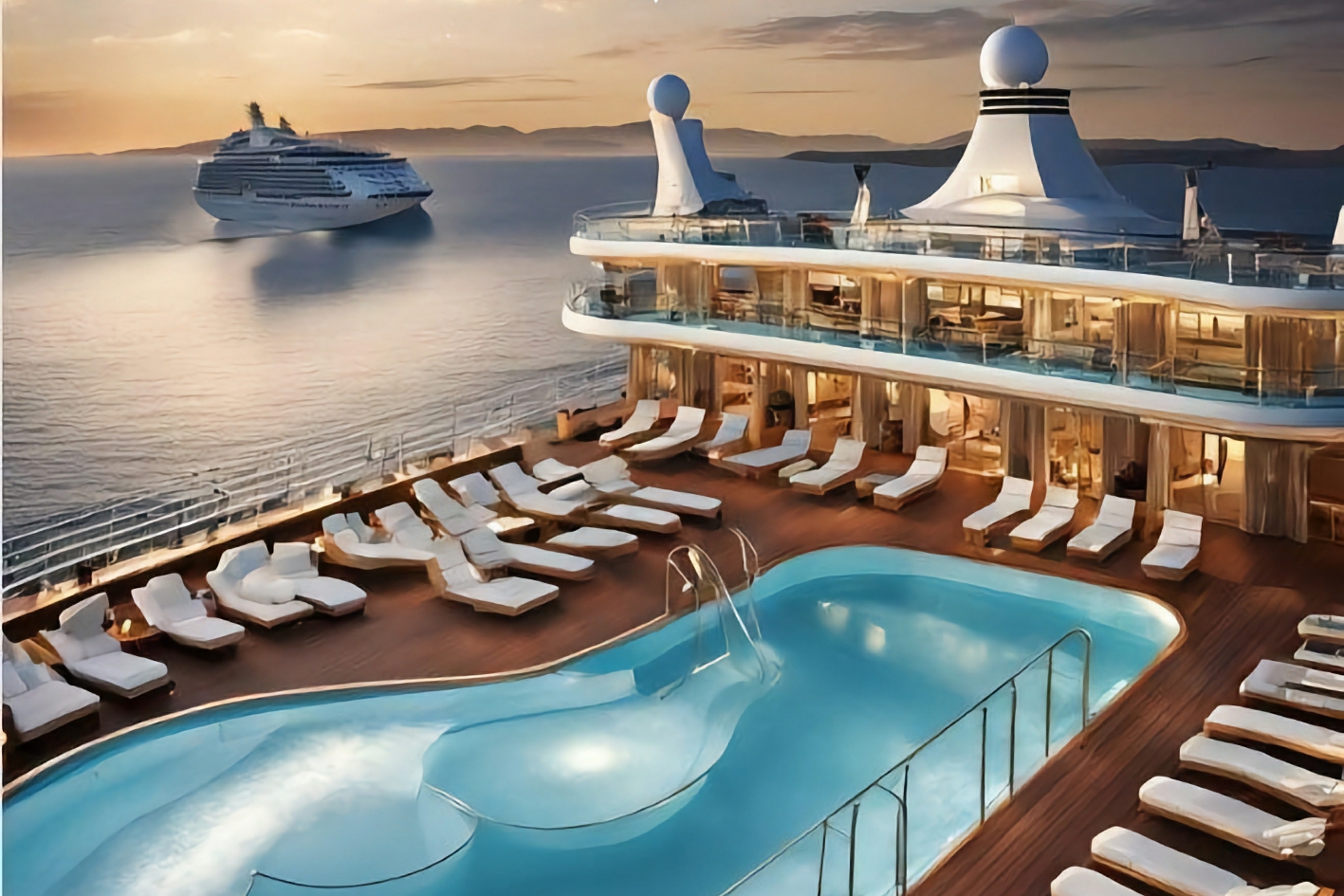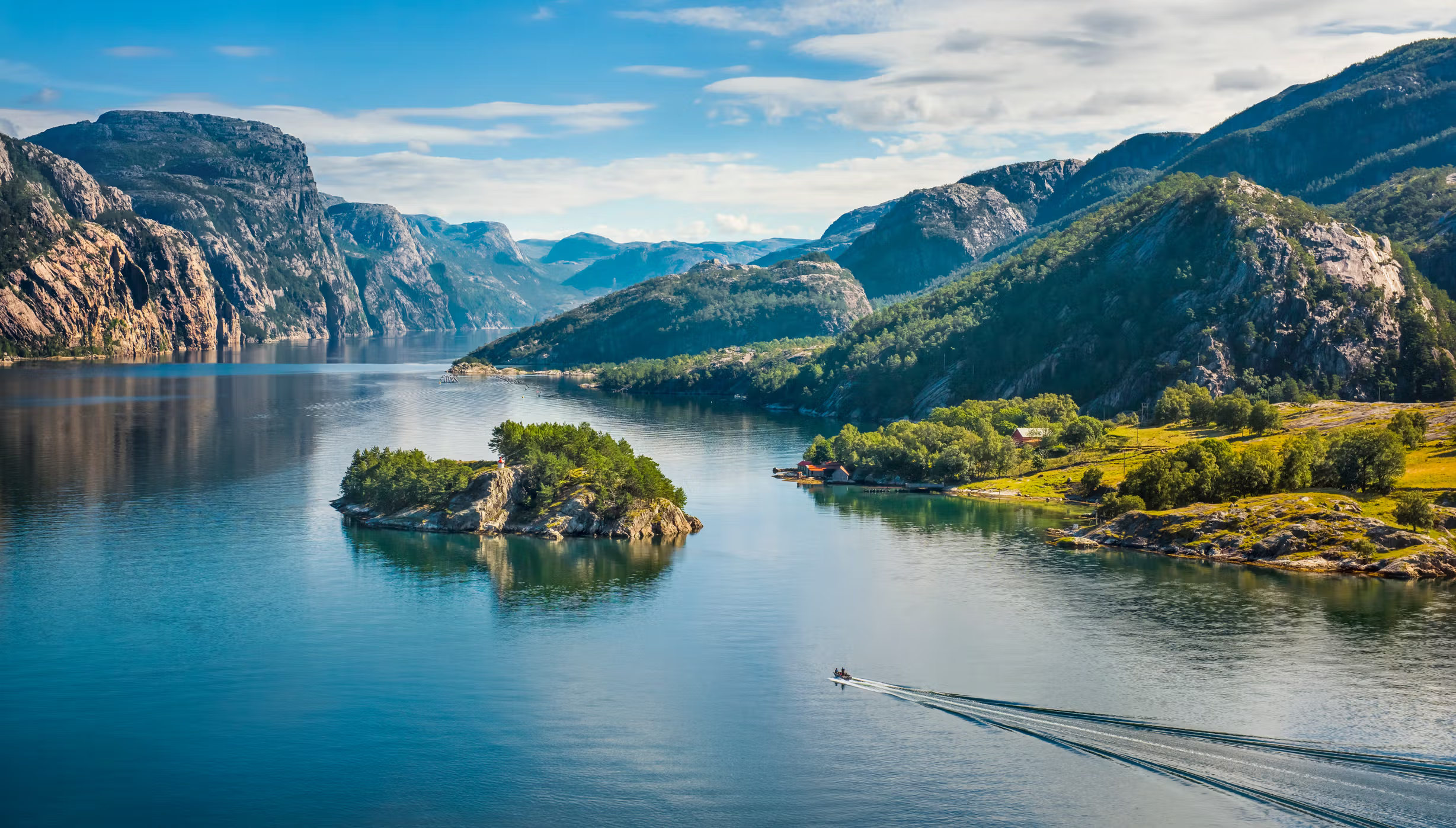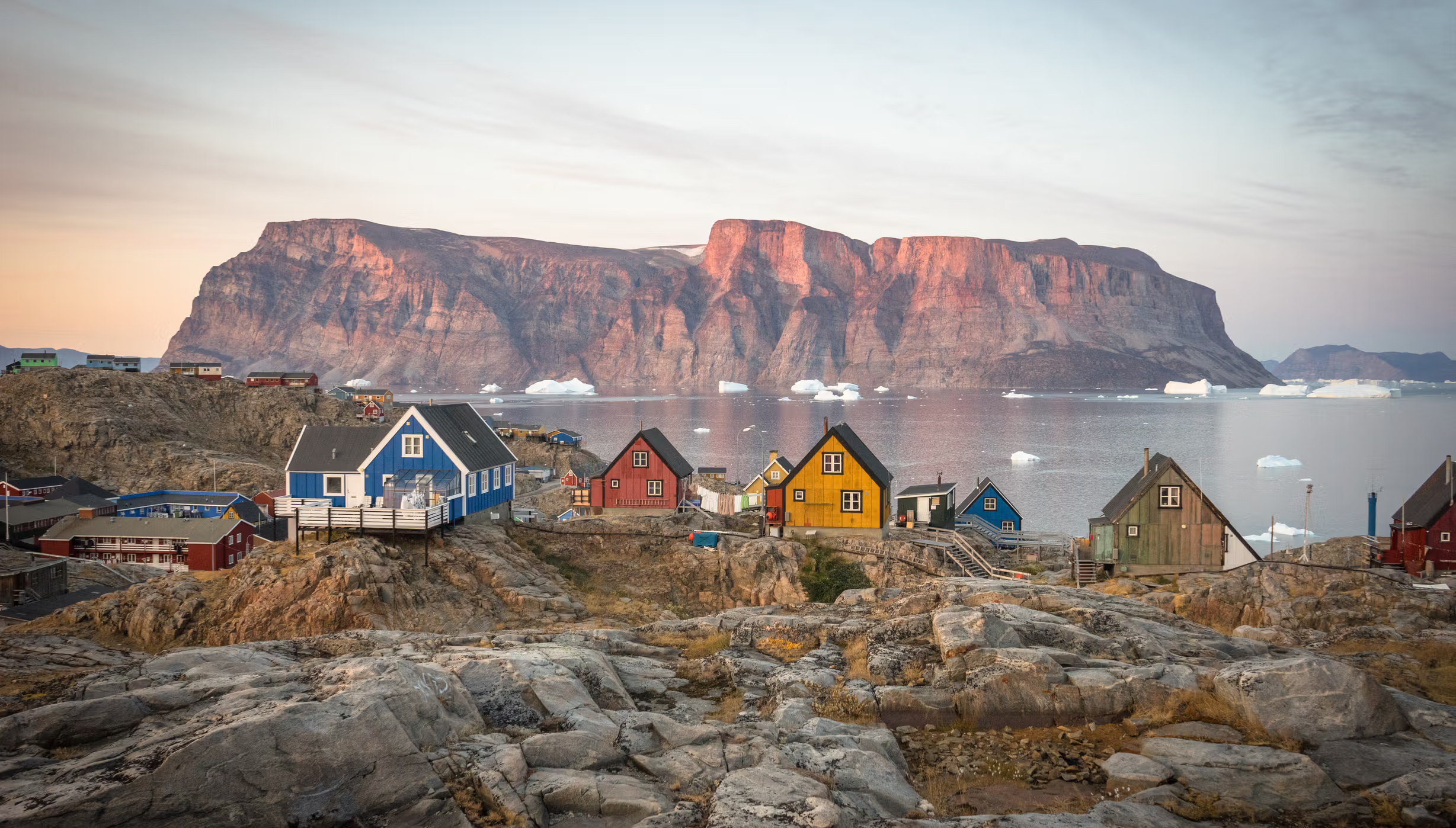Itinerary
Sometimes referred to as the Mother City, Cape Town is the most famous port in South Africa and is influenced by many different cultures, including Dutch, British and Malay. The port was founded in 1652 by Dutch explorer Jan Van Riebeeck, and evidence of Dutch colonial rule remains throughout the region. The port is located on one of the world’s most important trade routes, and is mainly a container port and handler of fresh fruit. Fishing is another vital industry, with large Asian fishing fleets using Cape Town as a logistical repair base for much of the year. The region is famous for its natural beauty, with the imposing Table Mountain and Lions Head, as well as the many nature reserves and botanical gardens such as Kirstenbosch which boasts an extensive range of indigenous plant life, including proteas and ferns. Cape Town’s weather is mercurial, and can change from beautiful sunshine to dramatic thunderstorms within a short period. A local adage is that in Cape Town you can experience four seasons in one day.
Day itinerary:
Sprawling across endless, staggeringly blue coastline, and watched over by the iconic plane of Table Mountain, Cape Town is without doubt one of the world’s most beautiful cities. A blend of spectacular mountain scenery, multiculturalism and relaxed ocean charm awaits in the Mother City, where you can venture out to rolling vineyards, dine in laid back sea suburbs, or spend days exploring cool urban culture. Cape Town’s natural splendour fully reveals itself as the cable car rears sharply to the top of Table Mountain. From the summit, 3,500 feet above sea level, you can let the scale of the panoramic vistas of the city rolling down towards the ocean wash over you. Another heavenly perspective waits at the top of Lion’s Head’s tapering peak. A sharp hike and an early start is required, but the views of the morning sun painting Table Mountain honey-gold are some of Cape Town’s finest. Cape Town’s glorious sunshine and inviting blue rollers can be a little deceiving – these oceans are anything but warm at times, with nothing between the peninsula’s end and Antarctica’s icy chill. This cool water has upsides though, bringing a colony of adorably cute African penguins to Boulders Beach. Boarded walkways offer the perfect vantage point to see the cute creatures dipping into the sea and lounging in the sun. Nearby, journey to the end of Africa at the Cape of Good Hope, where you can stand at the bottom of this mighty continent, watching out over the merging waves of the Atlantic and Indian Oceans. Cape Town’s beauty is counterpointed by the ominous island form, which sits four miles offshore from the bustling restaurants and lazy seals of the lively V&A Waterfront. A living history lesson, you can sail in the ships that transported prisoners out to Robben Island, before a former prisoner tells of the traumas of life on this offshore prison. Your guide will show you the cramped cells, and render Mandela’s long walk to freedom in heartbreaking, visceral clarity.
Originally the home of the San and Khoisan people and later the Xhosa tribe, the area now known as Gqeberha (previously Port Elizabeth) became a landing place for passing European ships after Portuguese navigator Bartolomew Diaz arrived in Algoa Bay in 1488. As part of the Cape Colony, the British occupied the area during the Napoleonic Wars and it was they who built Fort Frederick here in 1799. Twenty-one years later 4,000 settlers arrived, becoming the first permanent British residents of South Africa and Gqeberha. Sir Rufane Donkin, Acting Governor of the Cape Colony, founded Port Elizabeth, naming the settlement after his late wife. The town underwent rapid growth after 1873 following the construction of the railway to Kimberley, and is now one of the country’s major seaports. Like most South African cities, miles of beautiful coastline surround Gqeberha. Algoa Bay combines warm water and fair breezes, making it a mecca for swimmers and water sports enthusiasts. Those interested in history can follow the Donkin Heritage Trail, past a succession of Victorian and Edwardian town houses, trim gardens and neo-Gothic churches. Just outside the town are a number of game reserves, including the famous Addo Elephant National Park.
Day itinerary:
Port Elizabeth, or PE is an uncut gem of a destination. Loved by wealthy South African families as a holiday destination, it is a city has of faces. One: a natural haven with unspoiled beaches, rolling sand dunes and the warm Indian Ocean lapping at your feet and two: a post-industrial migrant city with a rich heritage. PE is also called Nelson Mandela Bay, and there is much here that celebrates him – starting with Route 67, a collection of 67 artworks honouring the 67 years that Mandela dedicated to achieving South Africa’s freedom. Known as “the friendly city”, Port Elizabeth is enjoying an urban regeneration, spurred on by the youth of the region that want to put it (back) on the map. Think vibrant creative projects spilling out wherever you go; a pedestrianised central zone, galleries selling local artworks, restaurants serving South African fusion food, award-winning buildings that house museums, restored Victorian terraces. Unsurprisingly, the boardwalk is buzzing. PE’s proximity to the excellent nature parks at Addo and Lalibela make it an ideal destination for game lovers. Both of these parks are a little way from PE (70 and 90 kilometres east respectively) but both offer a chance to revel in South Africa’s no holds barred natural beauty. This is the real reason why people come to South Africa – for a chance to see the fabled Big Five. Addo even boasts the Big Seven (lion, elephant, rhino, buffalo and leopard, as well as the great white shark and Southern right whale).
South Africa’s largest harbour is located on a lagoon on the Mhlatuze River on the northern coast of KwaZulu-Natal and takes its name from Admiral Sir F W Richards who sailed into the bay to deliver supplies to the troops during the Anglo/Zulu War of 1879. The Richards Bay lagoon was declared a game reserve in 1935, when conservationists objected to the growing industrialisation here. This however did nothing to halt development. Instead a compromise was agreed and a wall was built across the length of the bay to divide the lagoon. The north side became the seaport and the south remained a sanctuary for waterfowl and wildlife. The lagoon is famous for being the site where the longest crocodile ever recorded was shot by hunter John Dunn – it measured over 20 feet. The town was built on the shores of the lagoon in 1954 and although it was only a small fishing community in the 1960s, the development of the deep water harbour and railway in 1976 prompted the growth of the much larger township you see today. The bustling town is now a popular holiday destination with its unspoilt beaches at the edge of the Indian Ocean, year-round sunshine and excellent recreational facilities including surfing and fishing. It is also an excellent gateway to Zululand and the KwaZulu wildlife reserves. Richards Bay has recently undergone a major renovation that has given the town a Caribbean feel.
Day itinerary:
Considered as the official gateway to Zululand, Richard’s Bay has morphed from being a tiny fishing village into a bustling harbour town. Today, the 30 km2 lagoon is the major port of the region (and also the deepest in Africa), a growth spurred on by the significant mineral deposits, wonderful wetland scenery, unspoilt beaches and game reserves. Located on the north coast of KwaZulu-Natal, Richards Bay was for founded in 1879. British Rear Admiral Sir Frederick William Richards eponymously named the port after landing there during the Anglo-Zulu colonial wars. Despite its superlative natural setting, Richards Bay was long considered a southern African backwater, with as little as 200 residents as recently as 1969. This number grew when it was proclaimed a town, but even today it is relatively underpopulated, with fewer than 60,000 calling the province home. The town’s Zulu heritage is omnipresent so be sure to look out the local arts and crafts. Nearby Zulu village Dumazulu is the only Zulu village to be opened up to tourism by King Goodwill Zwelithini, and the only authentic example of Zulu traditions that foreigners are allowed to into. If African culture is not your cup of tea, the hinterland offers fascinating flora and fauna, including a chance to see the incredibly rare white rhino along with the bucket list Big Five. Richards Bay’s attractions can be found closer to port too – the 350 kilometres of coastland, also known as “Dolphin coast”, are a joy for divers and beach lovers alike.
Day itinerary:
Bazaruto Island lies within the eponymously named archipelago, which forms a chain of barrier islands a short distance off the coast of Mozambique. The archipelago became a National Park in 1971 in recognition of its precious and varied flora and fauna, including iconic animals such as sea turtles and dugongs. At least 170 bird species have been recorded across the 6 islands and nearby waters, along with 48 species of reptiles, 21 land mammals, 9 marine mammals, 500 species of mollusc and 2000 species of fish. Sighting even a small fraction of this diverse assemblage of wildlife will make the journey to Bazaruto Island worthwhile. The protected western coastline exudes the air of tropical tranquillity, with palm trees casting shade on white sand beaches that are lapped by clear warm waters. If not swimming then delve deeper into the interior to see if, with your ship’s ornithologist you can differentiate between Blue-cheeked and Madagascar Bee-eater as they intently scan for flying insects from their prominent perches. More identifiable perhaps are the Common Waxbills, zebra-like with a striking scarlet mask, and occurring in boisterous flocks in grassy and reedy areas. Don’t think for a minute that the hunt for exotic wildlife is easy – it can remain hidden despite ear-shattering shrieks that belie its obviousness – but for those who are patient and persevere, the bragging rights at dinner are endless, if you have seen for example, the golden blind legless skink, a sub-species endemic to the island.
Day itinerary:
The densely populated Mozambique Island is small at only 3 km (1.9 miles) long and less than 500 meters (650 yards) wide. The Portuguese had already settled here by 1507, and the oldest European building in the southern hemisphere is found on Mozambique Island: the Chapel of Nossa Senhora de Baluarte. Fort São Sebastião also dates back to the 16th century. Historical buildings on the northern side of the island include the Palace and Chapel of São Paulo, built in 1610 as a Jesuit College — later converted to be the Governor’s Residence, and now a museum. As a result of its rich history and architectural remains, the Island of Mozambique is a UNESCO World Heritage Site. The majority of the residents today live in reed houses in Makuti Town at the southern end of the island. In addition to the old Christian churches there are several mosques and even a Hindu temple on the island. For the last 55 years a 3 km (1.9 mile) bridge has connected the island to the mainland.
Day itinerary:
Kilwa Kisiwani dates back to the 9th century as one of the most famous trading posts in East Africa and on the Indian Ocean. From the 11th century to early 15th century this island community off the southern coast of present-day Tanzania was a powerful city, political force, and major trading center with close links to the interior of Africa as well as distant Asian ports. Goods exchanged here included gold, iron, ivory, slaves, textiles, jewelry, porcelain and spices. Today, Kilwa Kisiwani is a UNESCO World Heritage site whose ancient ruins can be explored on foot. From the Malindi Mosque and cemetery, to Fort Gereza, the tombs of the sultans, several mosques, and the Great House, the site allows the imagination to experience the Kilwa Sultanate that once ruled here. Highlights include a fourteenth century palace — no structure of its size was built anywhere else along the coast – and a fortified enclosure, very similar to structures found in Syria, Turkey and the Persian Gulf.
This ancient isle once ruled by sultans and slave traders served as the stepping stone into the African continent for missionaries and explorers. Today it attracts visitors intent on discovering sandy beaches, pristine rain forests, or colorful coral reefs. Once known as the Spice Island for its export of cloves, Zanzibar has become one of the most exotic flavors in travel, better than Bali or Mali when it comes to beauty that’ll make your jaw drop.Separated from the mainland by a channel only 35 km (22 miles) wide, and only 6 degrees south of the equator, this tiny archipelago—the name Zanzibar also includes the islands of Unguja (the main island) and Pemba—in the Indian Ocean was the launching base for a romantic era of expeditions into Africa. Sir Richard Burton and John Hanning Speke used it as their base when searching for the source of the Nile. It was in Zanzibar where journalist Henry Morton Stanley, perched in an upstairs room overlooking the Stone Town harbor, began his search for David Livingstone.The first ships to enter the archipelago’s harbors are believed to have sailed in around 600 BC. Since then, every great navy in the Eastern Hemisphere has dropped anchor here at one time or another. But it was Arab traders who left an indelible mark. Minarets punctuate the skyline of Stone Town, where more than 90% of the residents are Muslim. In the harbor you’ll see dhows, the Arabian boats with triangular sails. Islamic women covered by black boubou veils scurry down alleyways so narrow their outstretched arms could touch buildings on both sides. Stone Town received its odd name because most of its buildings were made of limestone and coral, which means exposure to salty air has eroded many foundations.The first Europeans who arrived here were the Portuguese in the 15th century, and thus began a reign of exploitation. As far inland as Lake Tanganyika, slave traders captured the residents or bartered for them from their own chiefs, then forced the newly enslaved to march toward the Indian Ocean carrying loads of ivory tusks. Once at the shore they were shackled together while waiting for dhows to collect them at Bagamoyo, a place whose name means, “here I leave my heart.” Although it’s estimated that 50,000 slaves passed through the Zanzibar slave market each year during the 19th century, many more died en route.Tanganyika and Zanzibar merged in 1964 to create Tanzania, but the honeymoon was brief. Zanzibar’s relationship with the mainland remains uncertain as calls for independence continue. “Bismillah, will you let him go,” a lyric from Queen’s “Bohemian Rhapsody,” has become a rebel chant for Zanzibar to break from Tanzania.Zanzibar Island, locally known as Unguja, has amazing beaches and resorts, decent dive spots, acres of spice plantations, the Jozani Forest Reserve, and Stone Town. Plus, it takes little more than an hour to fly there. It’s a popular spot to head post-safari.Stone Town, the archipelago’s major metropolis, is a maze of narrow streets lined with houses featuring magnificently carved doors studded with brass. There are 51 mosques, 6 Hindu temples, and 2 Christian churches. And though it can rightly be called a city, much of the western part of the larger island is a slumbering paradise where cloves, as well as rice and coconuts, still grow.Although the main island of Unguja feels untouched by the rest of the world, the nearby islands of Pemba and Mnemba offer retreats that are even more remote. For many years Arabs referred to Pemba as Al Khudra, or the Green Island, and indeed it still is, with forests of king palms, mangos, and banana trees. The 65-km-long (40-mile-long) island is less famous than Unguja except among scuba divers, who enjoy the coral gardens with colorful sponges and huge fans. Archaeology buffs are also discovering Pemba, where sites from the 9th to the 15th century have been unearthed. At Mtambwe Mkuu coins bearing the heads of sultans were discovered. Ruins along the coast include ancient mosques and tombs. In the 1930s Pemba was famous for its sorcerers, attracting disciples of the black arts from as far away as Haiti. Witchcraft is still practiced, and, oddly, so is bullfighting. Introduced by the Portuguese in the 17th century, the sport has been improved by locals, who rewrote the ending. After enduring the ritual teasing by the matador’s cape, the bull is draped with flowers and paraded around the village.Beyond Pemba, smaller islands in the Zanzibar Archipelago range from mere sandbanks to Changu, once a prison island and now home to the giant Aldabra tortoise, Chumbe Island, and Mnemba, a private retreat for guests who pay hundreds of dollars per day to get away from it all.
Day itinerary:
A tropical paradise, with swathes of long white sand and flanked by tall, skinny, palm trees, Zanzibar sits in the clear blue waters of the Indian Ocean. Part of the Zanzibar archipelago, the island – also confusingly called Zanzibar – is found just 22 miles from mainland Tanzania. Considered today as a honeymooners’ paradise, visitors will find vestiges of both Arabic and Portuguese colonialism (the island was Portuguese until 1698 when it was seized by the Sultanate of Oman), amid the picture perfect landscape. But there is much more to Zanzibar than meets the eye. With just one step off the ship, and you are already breathing the heady scents of nutmeg, cinnamon, vanilla and cloves. Rightfully known as the Spice Isle, Zanzibar was once a trading hotspot on the trading route from Arabia to Africa. At the time, the island enjoyed an influx of wealth and European bourgeoisie, with spices being traded at astronomical prices. The influences of the various colonies are glamorously reflected in the main city’s architecture. But sensual smells and beautiful beaches aside, Zanzibar has the vestiges of sinister history. The island was a capital for the slave trade in the 19th century, with an estimated 50,000 slaves passing through the Zanzibar slave market each year, with many more dying en route. The epicentre for trade was in the Market Square, in the heart of Stone Town, a melting pot of Arabic, African and European history that today is one of the world’s most popular UNESCO World Heritage Sites.
Day itinerary:
Assumption (Assomption) Island is a small, crescent shaped island about 4.3 square miles (11.07 sq km) in size. Considered one of the Outer Seychelles Islands, Assumption is part of the Aldabra Group, lying approximately 600 miles (960 km) southwest of Mahé, in the Indian Ocean. These outer islands are not made from granite, like their larger sisters Mahé, Praslin or La Digue, but rather are coralline formations. Once a part of the French colony Réunion, then a member of the British Indian Ocean Territories, today Assumption is governed by the Seychelles. Assumption is a rough and arid island, shaded only by shrubs and palm trees but is redeemed by a spectacular reef with huge coral heads and a white ocean floor. Jacques Cousteau said he’d never seen any other place on earth with same clarity of water or diversity of reef life. He filmed large parts of documentary “The Silent World” here, and held audiences across the globe, spellbound by the magic that lay beneath the sea. A notable feature of this island is the Assumption Island day gecko, a subspecies of gecko found only on this island. Assumption is also a known nesting site for turtles and rare birds. Because Assumption Island was found to be rich in guano, coveted for its phosphorous fertilizing abilities, it was essentially plundered in the early 1900s. The island today is has an interesting geography that includes a gorgeous 3-mile (5-km) white beach, a rocky coastline, caves, and two very large sand dunes prominent on the south eastern coast of the island, one of them reaching 104 feet (32 metres) high. There is a very small settlement with less than 10 registered inhabitants, mostly in place to service the small landing strip used by scientists with permission to study the neighbouring Aldabra Atoll. The settlement is surrounded by Casuarina trees and there is an abandoned coconut palm plantation to its south. Pier Information The ship will be anchored off the coast of Assumption and tenders will land on the shoreline. We recommend you wear sturdy walking shoes, sun hats or scarves and bring your camera. Independently explore the island and relax on this peaceful dot in the ocean.
A hidden gem in a faraway archipelago, Aldabra Atoll is one of the last virtually untouched sanctuaries on earth.Listed as a UNESCO World Heritage Site, Aldabra Atoll is formed by 4 large coral reef islands and 40 smaller islands and rocks. It is one of the world’s most wild and remote regions with the larger reefs surrounding a shallow lagoon teeming with black-tipped sharks, sea turtles and manta rays in the centre of the atoll. Aldabra Atoll truly is a spectacular wonder that is rich in wildlife with Aldabra giant tortoises outnumbering the human population in Seychelles.
Day itinerary:
Part of the Outer Islands of the Seychelles, Aldabra is reputedly the world’s second-largest atoll and has been described as “one of nature’s treasures” and a “sanctuary”. The inner lagoon teems with marine life like eagle rays and sea turtles. It is possible to snorkel and drift along with the tide passing in or out of the lagoon as massive numbers of fish come and go through the same channels. Narrow channels between fossilized coral islands are fringed in mangrove forests supporting large colonies of nesting boobies and Great Frigatebirds. Its distinctive island fauna includes the Aldabra giant tortoise (Aldabrachelys gigantea). Approximately two-thirds of the world’s population of giant tortoises lives on Aldabra – some 100,000 out of a reported 150,000. Because of its extreme isolation in the blue of the Indian Ocean, and due to a lack of freshwater, the island has not been developed for tourism. No airport has been built, and only a handful of smaller ships with special permits are allowed to call at this unique atoll.
A hidden gem in a faraway archipelago, Aldabra Atoll is one of the last virtually untouched sanctuaries on earth.Listed as a UNESCO World Heritage Site, Aldabra Atoll is formed by 4 large coral reef islands and 40 smaller islands and rocks. It is one of the world’s most wild and remote regions with the larger reefs surrounding a shallow lagoon teeming with black-tipped sharks, sea turtles and manta rays in the centre of the atoll. Aldabra Atoll truly is a spectacular wonder that is rich in wildlife with Aldabra giant tortoises outnumbering the human population in Seychelles.
Day itinerary:
Part of the Outer Islands of the Seychelles, Aldabra is reputedly the world’s second-largest atoll and has been described as “one of nature’s treasures” and a “sanctuary”. The inner lagoon teems with marine life like eagle rays and sea turtles. It is possible to snorkel and drift along with the tide passing in or out of the lagoon as massive numbers of fish come and go through the same channels. Narrow channels between fossilized coral islands are fringed in mangrove forests supporting large colonies of nesting boobies and Great Frigatebirds. Its distinctive island fauna includes the Aldabra giant tortoise (Aldabrachelys gigantea). Approximately two-thirds of the world’s population of giant tortoises lives on Aldabra – some 100,000 out of a reported 150,000. Because of its extreme isolation in the blue of the Indian Ocean, and due to a lack of freshwater, the island has not been developed for tourism. No airport has been built, and only a handful of smaller ships with special permits are allowed to call at this unique atoll.
A hidden gem in a faraway archipelago, Aldabra Atoll is one of the last virtually untouched sanctuaries on earth.Listed as a UNESCO World Heritage Site, Aldabra Atoll is formed by 4 large coral reef islands and 40 smaller islands and rocks. It is one of the world’s most wild and remote regions with the larger reefs surrounding a shallow lagoon teeming with black-tipped sharks, sea turtles and manta rays in the centre of the atoll. Aldabra Atoll truly is a spectacular wonder that is rich in wildlife with Aldabra giant tortoises outnumbering the human population in Seychelles.
Day itinerary:
Part of the Outer Islands of the Seychelles, Aldabra is reputedly the world’s second-largest atoll and has been described as “one of nature’s treasures” and a “sanctuary”. The inner lagoon teems with marine life like eagle rays and sea turtles. It is possible to snorkel and drift along with the tide passing in or out of the lagoon as massive numbers of fish come and go through the same channels. Narrow channels between fossilized coral islands are fringed in mangrove forests supporting large colonies of nesting boobies and Great Frigatebirds. Its distinctive island fauna includes the Aldabra giant tortoise (Aldabrachelys gigantea). Approximately two-thirds of the world’s population of giant tortoises lives on Aldabra – some 100,000 out of a reported 150,000. Because of its extreme isolation in the blue of the Indian Ocean, and due to a lack of freshwater, the island has not been developed for tourism. No airport has been built, and only a handful of smaller ships with special permits are allowed to call at this unique atoll.
La Digue Island is an island like no other. It is the smallest of the three populated islands in the Seychelles, but the tranquillity will make it feel like you’re the only one there.The stunning surroundings should be soaked up from cycling through the vanilla plantations to lying on the white-sandy beaches, your time on La Digue should be cherished.There is a little more to do on La Digue compared to the smaller, uninhabited islands where you can enjoy full moon tours, surfing and snorkelling with a local.
Day itinerary:
Urbanites look away. You’ll find no bright lights or big cities here. The attraction of La Digue is that there are no none. Instead it’s just long ribbons of perfect beach, lush inland forests and enough kaleidoscopic coral reef to make any diver weak at the knees. Because of La Digue’s proximity to both Praslin and Mahe, it is considered part of the holy trinity of the Seychelles. But that is not to say that it’s a hot spot. On the contrary, life is taken at a slow pace here – transport is by bicycle or ox-cart (there are rumours that motor taxis exist but for now that’s just hearsay), entertainment is a slow walk on paths shaded by tropical flowers, and life hums to the rhythm of bygone days. That is the true attraction of La Digue, the very other wordiness of the island; the feeling that nothing has changed since the 18th century. In fact, some of the residents (called Digueois) still carry the names of their forefathers, who arrived as slaves with the French colonialists in 1789. The island’s beaches are, of course, legendary. The jewel in La Digue’s crown (and there are so many) would have to be La Anse Source d’Argent, frequently considered as one of the most beautiful beaches on the planet. This is truly the Holy Grail – a long string of powdery, white sand, bordered by the crystal clear waters of the Indian Ocean. Scattered around the beach and shore are smooth granite boulders that form coves and caves and provide home for some of the most colourful underwater life you’re ever likely to see.
Like jade-coloured jewels in the Indian Ocean, the more than 100 Seychelles Islands are often regarded as the Garden of Eden. Lying just four degrees south of the equator, the Seychelles are some 1,000 miles (1,610 km) from the nearest mainland Africa. Little more than 200 years ago, all 115 islands were uninhabited. Then in 1742 a French ship dispatched from Mauritius sailed into one of the small bays. Captain Lazare Picault was the first to explore these unnamed islands. He encountered breathtaking vistas of rugged mountains, lagoons, coral atolls, splendid beaches and secluded coves. After Picault sailed away, the islands remained untouched for the next 14 years. Then France took possession of the seven islands in the Mahé group. During an expedition Captain Morphey named them the Sechelles, in honour of Vicomte Moreau de Sechelles. This name was later anglicised to Seychelles. The first settlers arrived at St. Anne’s Island in 1770; 15 years later the population of Mahé consisted of seven Europeans and 123 slaves. Today there are about 80,000 Seychellois, the majority of whom live on Mahé; the rest are scattered in small communities throughout the archipelago. The people are a fusion of three continents – Africa, Asia and Europe. This has created a unique culture and the use of three languages – Creole, French and English. Mahé is the largest island in the archipelago and the location of the capital, Victoria. Ringed by steep, magnificent mountains, few capitals can claim a more beautiful backdrop. The town features a mixture of modern and indigenous architecture; it is the centre of business and commerce thanks to the extensive port facilities. Noteworthy sites in Victoria are the museum, cathedral, government house, clock tower, botanical gardens and an open-air market. The major attractions are found outside of town where the island’s quiet, lazy atmosphere delights visitors. With 68 pristine, white sand beaches, Mahé boasts more beaches and tourist facilities than any of the other Seychelles Islands. Beautiful and remote Mahé with its green-clad mountains and palm-fringed beaches is indeed an island of abundance; pleasant surprises are around every bend in the trail. Come ashore and discover for yourself this marvellous island paradise.
Day itinerary:
Few places on Earth can claim to have been as blessed by nature as Mahe. Set in the remote Seychelles archipelago over 1,500 kilometres east of Mombasa, Mahe is largest of the 115 islands and is home to so many stunning attractions you won’t know where to begin. For many the Seychelles are the destination of a lifetime. Cerulean seas, miles and miles of beach, lush, tropical jungle and surreal, natural beauty as far as the eye can see. Not only does Mahe boast 68 pristine beaches, it is dominated by the towering peaks of the Morne Seychellois National Park. This splendid National Park takes up over 20% of the island and is home to a vast amount of endemic flora and fauna, including the ultra-rare Seychelles Scops-owl. Unsurprisingly, the crystal clear waters are a diver’s heaven, promising a colourful cornucopia of underwater life, regardless of how experienced you are. Despite the island being visited in 1609 by the British, Mahe did not feature on any maps until 1742, when Frenchman Lazare Picault explored the as yet unnamed islands. However, it took a further 14 years for the French to lay claim to the islands, with the arrival of naval ship Le Cerf, captained by Corneille Morphey who christened the archipelago after Vicomte Moreau de Sechelles. He did this by setting down a Stone of Possession, which is on display in the National Museum. The first settlers arrived in 1770 and 15 years later the population had swelled to 130 – 7 Europeans and 123 slaves. Today, there are 80,000 Seychellois.
Ship features
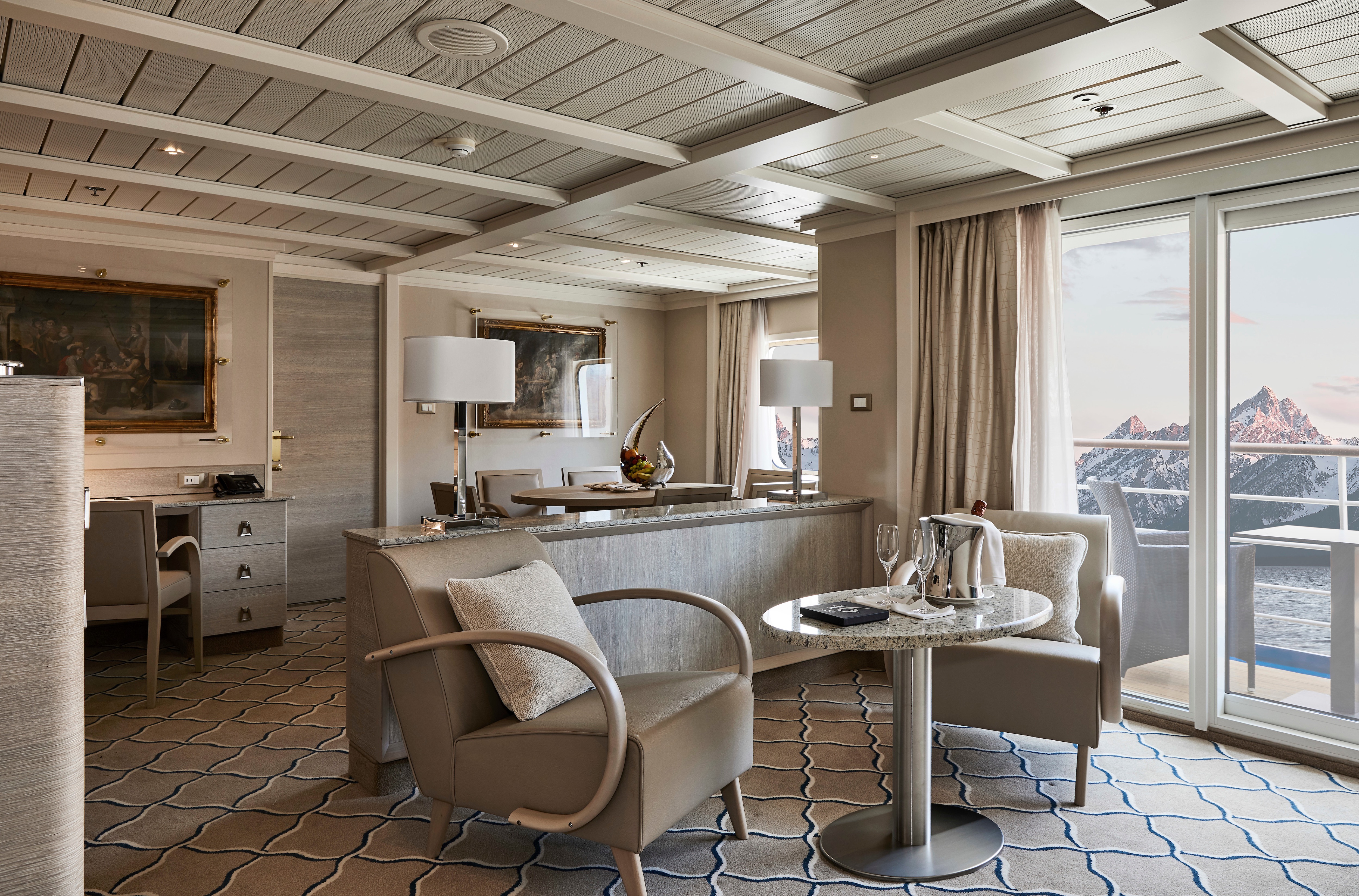
Owner's Suite
This stylish apartment offers the superlative in levels of space, comfort, and service on board. A perfect mix of expedition experience with luxury lifestyle. Available in a one-bedroom configuration or as two bedrooms by adjoining with a Vista Suite.
One bedroom: 55 sq m including veranda (8 sq m)
Two bedrooms: 77 sq m including veranda (8 sq m)
Images are intended as a general reference. Features, materials, finishes and layout may be different than shown.
Please note that the 3rd guest will sleep on a comfortable sofa bed in the reception area of the suite.
Essentials
- Deck(s): 7
- Section: Mid-Ship
Characteristics
- Veranda
- Separate dining area
- Living room with sitting area
- Standard vanity
- Separate shower
- Whirlpool bath
- Walk-in wardrobe with personal safe
Furniture
- King size bed
- Writing desk
- Vanity table
- Luxury bed mattresses
Media & Communication
- Unlimited Premium Wi-Fi
- 2 large flat screen TVs with Interactive Media Library
- Sound system with bluetooth connectivity
- Direct dial telephone
- Wall mounted USB-C mobile device chargers
- Dual voltage 110/220 outlets
Onboard Services
- Butler service
- Complimentary laundry, pressing & wet cleaning
- Daily canapé service, Welcome chocolate, Welcome fruit stand
- Dinner for two in La Dame, one evening per voyage,
- Two hours of worldwide phone use, per voyage segment
- Champagne on arrival
Amenities
- Espresso machine
- Pillow menu
- Refrigerator and bar setup stocked with your preferences
- Plush bathrobe
- Luxury bath amenities
- Umbrella
- Hair Dryer
- Slippers
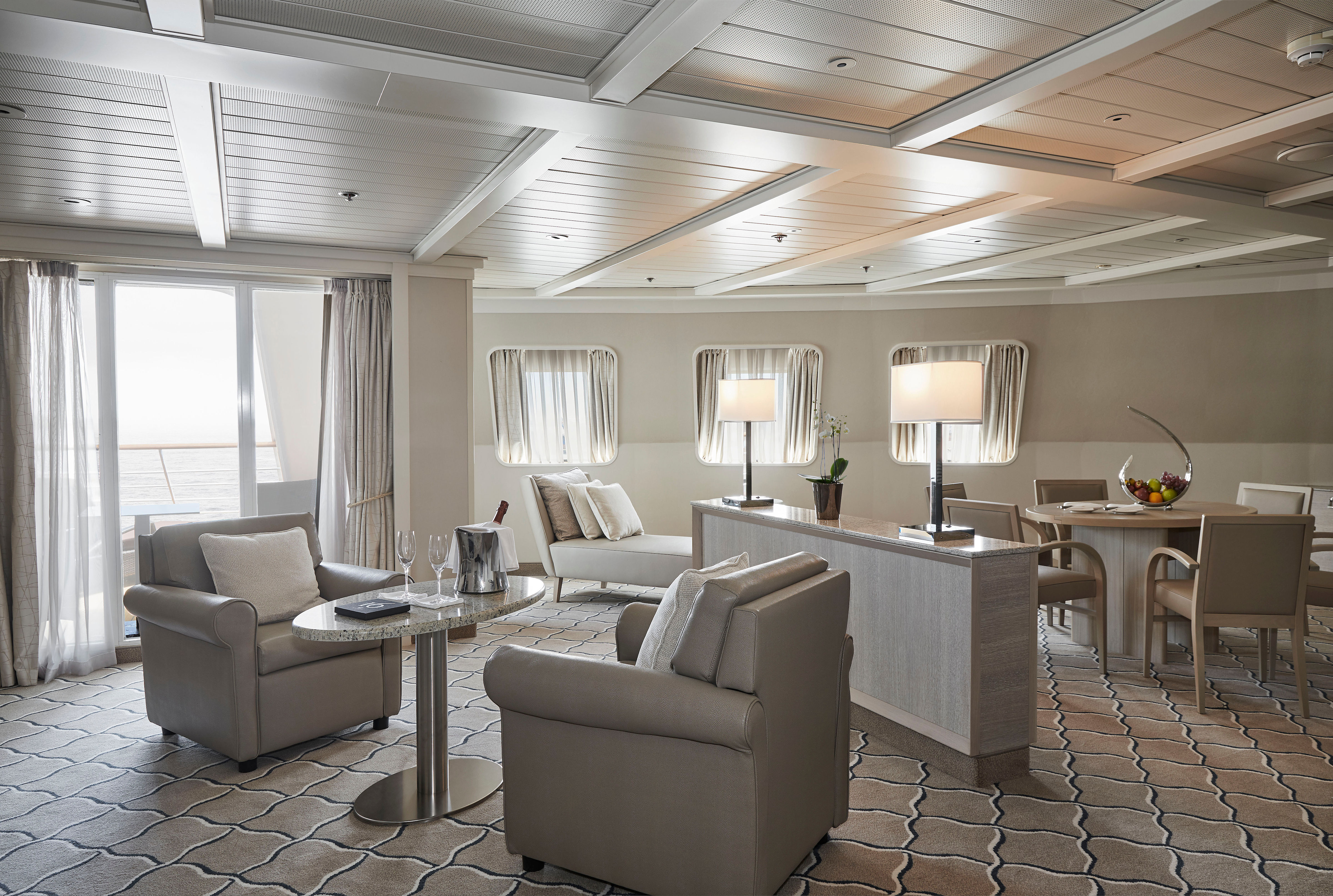
Grand Suite
Expertly designed and exquisitely appointed. The ideal space for sharing stories with fellow explorers and new friends. With enough space to roam both inside and outside, this suite is perfect for relaxing and recounting the highlights of your day. Available in a one-bedroom configuration or as two bedrooms by adjoining with a Veranda Suite.
One bedroom: 95 sq m including veranda (14 sq m)
Images are intended as a general reference. Features, materials, finishes and layout may be different than shown.
Please note that the third guest will sleep on a comfortable sofa bed in the reception area of the suite.
Two bedrooms: 122 sq m including veranda (18.5 sq m)
Images are intended as a general reference. Features, materials, finishes and layout may be different than shown.
Please note that the 3rd guest will sleep on a comfortable sofa bed in the reception area of the suite.
Essentials
- Deck(s): 7
- Section: Forward
Characteristics
-
Veranda
- Separate dining area
- Living room with sitting area
- Standard vanity
- Separate shower
- Whirlpool bath
- Walk-in wardrobe with personal safe (Wardrobe closet in suite 702 & 703)
Furniture
- King size bed
- Writing desk
- Vanity table
- Luxury bed mattresses
Media & Communication
- Unlimited Premium Wi-Fi
- 2 large flat screen TVs with Interactive Media Library
- Sound system with bluetooth connectivity
- Direct dial telephone
- Wall mounted USB-C mobile device chargers
- Dual voltage 110/220 outlets
Onboard Services
-
Butler service
- Complimentary laundry, pressing & wet cleaning
- Dinner for two in La Dame, one evening per voyage,
- Two hours of worldwide phone use, per voyage segment
- Champagne on arrival
Amenities
- Espresso machine
- Pillow menu
- Refrigerator and bar setup stocked with your preferences
- Plush bathrobe
- Luxury bath amenities
- Umbrella
- Hair Dryer
- Slippers

Royal Suites
Stately. Commanding and majestic. Perfect for relaxing after a days’ exploring and looking through your photos. With lectures streamed live to your room, this is the pinnacle of good living at sea. Available in a one-bedroom configuration or as two bedrooms by adjoining with a Veranda Suite.
One bedroom: 69 sq m including veranda (12 sq m)
Two bedrooms: 96 sq m including veranda (16.5 sq m)
Images are intended as a general reference. Features, materials, finishes and layout may be different than shown.
Please note that the third guest will sleep on a comfortable sofa bed in the reception area of the suite.
Essentials
- Deck(s): 6
- Section: Forward
Characteristics
- Veranda
- Separate dining area
- Living room with sitting area
- Standard vanity
- Separate shower
- Whirlpool bath
- Walk-in wardrobe with personal safe
Furniture
- King size bed
- Writing desk
- Vanity table
- Luxury bed mattresses
Media & Communication
- Unlimited Premium Wi-Fi
- 2 large flat screen TVs with Interactive Media Library
- Sound system with bluetooth connectivity
- Direct dial telephone
- Wall mounted USB-C mobile device chargers
- Dual voltage 110/220 outlets
Onboard Services
- Butler service
- Complimentary laundry, pressing & wet cleaning
- Dinner for two in La Dame, one evening per voyage,
- Two hours of worldwide phone use, per voyage segment
- Champagne on arrival
Amenities
- Espresso machine
- Pillow menu
- Refrigerator and bar setup stocked with your preferences
- Plush bathrobe
- Luxury bath amenities
- Umbrella
- Hair Dryer
- Slippers
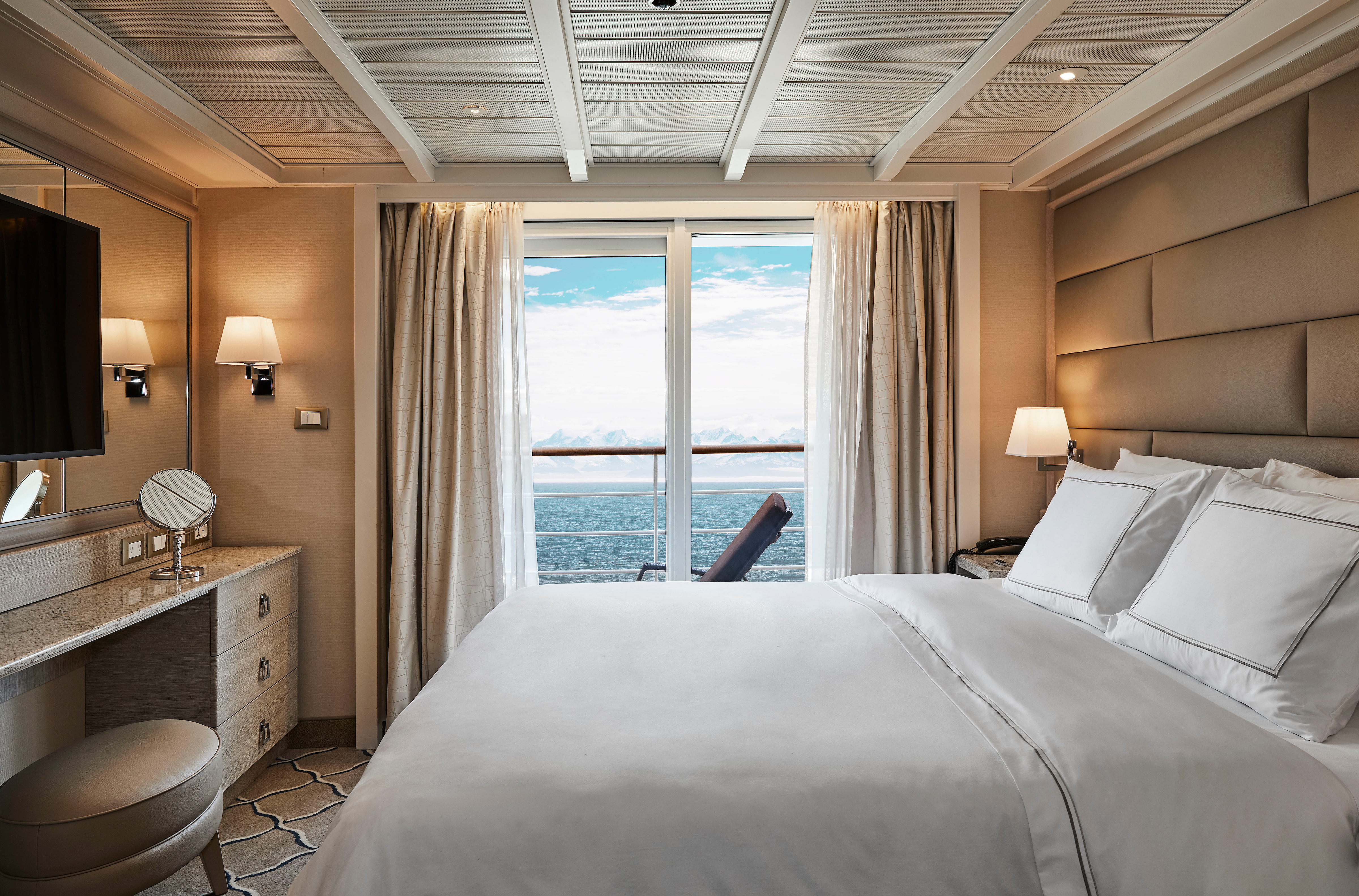
Silver Suite
Stylish and sophisticated with larger verandas, excellent for taking pictures and bird-watching. Situated midship, this suite is perfection in design and comfortable living. A huge walk-in wardrobe, a beautiful marbled bathroom, and a spacious living area complete the picture. Silver Suites accommodate three guests.
One bedroom: 54 sq m including veranda (8 sq m)
Images are intended as a general reference. Features, materials, finishes and layout may be different than shown.
Please note that the 3rd guest will sleep on a comfortable sofa bed in the reception area of the suite.
Essentials
- Deck(s): 6, 7
- Section: Mid-Ship
Characteristics
- Veranda
- Separate dining area
- Living room with sitting area
- Standard vanity
- Separate shower
- Full-size bath
- Walk-in wardrobe with personal safe
Furniture
- Queen size bed
- Writing desk
- Vanity table
- Luxury bed mattresses
Media & Communication
- Unlimited Premium Wi-Fi
- 2 large flat screen TVs with Interactive Media Library
- Sound system with bluetooth connectivity
- Direct dial telephone
- Wall mounted USB-C mobile device chargers
- Dual voltage 110/220 outlets
Onboard Services
- Butler service
- Complimentary laundry, pressing & wet cleaning
- Champagne on arrival
Amenities
- Espresso machine
- Pillow menu
- Refrigerator and bar setup stocked with your preferences
- Plush bathrobe
- Luxury bath amenities
- Umbrella
- Hair Dryer
- Slippers
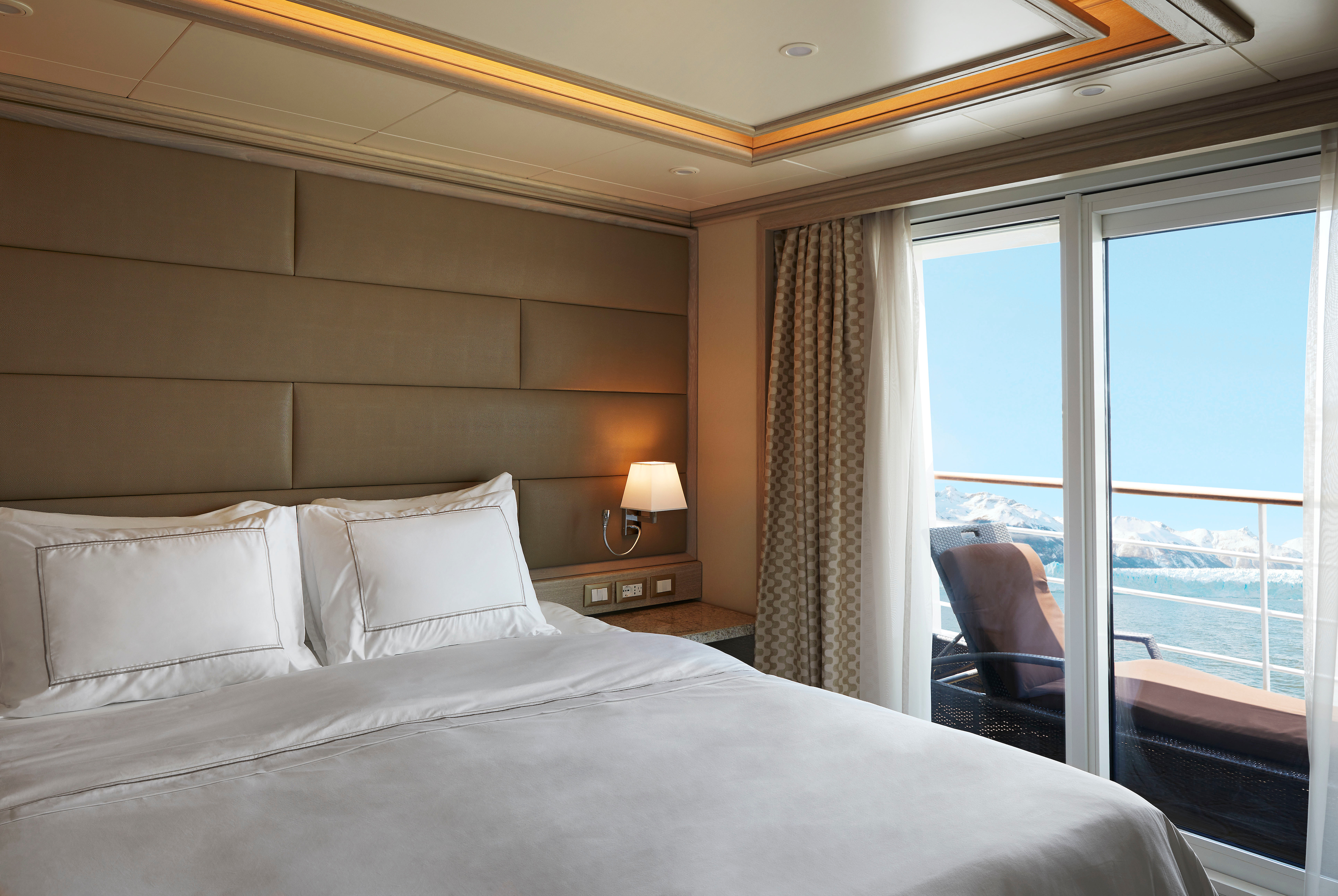
Medallion Suite
With a room configuration that favors watching the sun rise from the comfort of your bed and losing yourself in the mesmerizing seascapes, this suite is the perfect answer to adventure cruising. A large walk-in wardrobe and an expansive living room make the Medallion Suite your home away from home on the high seas. Medallion Suites accommodate three guests.
One bedroom: 48 sq m including veranda (7.6 sq m )
Images are intended as a general reference. Features, materials, finishes and layout may be different than shown.
Please note that the 3rd guest will sleep on a comfortable sofa bed in the reception area of the suite.
Essentials
- Deck(s): 5, 6, 7
- Section: Mid-Ship
Characteristics
- Veranda
- Separate dining area
- Living room with sitting area
- Standard vanity
- Separate shower
- Walk-in wardrobe with personal safe
Furniture
- Queen size bed
- Writing desk
- Vanity table
- Luxury bed mattresses
Media & Communication
- Unlimited Premium Wi-Fi
- 2 large flat screen TVs with Interactive Media Library
- Sound system with bluetooth connectivity
- Direct dial telephone
- Wall mounted USB-C mobile device chargers
- Dual voltage 110/220 outlets
Onboard Services
- Butler service
- Complimentary laundry, pressing & wet cleaning
- Champagne on arrival
Amenities
- Espresso machine
- Pillow menu
- Refrigerator and bar setup stocked with your preferences
- Plush bathrobe
- Luxury bath amenities
- Umbrella
- Hair Dryer
- Slippers
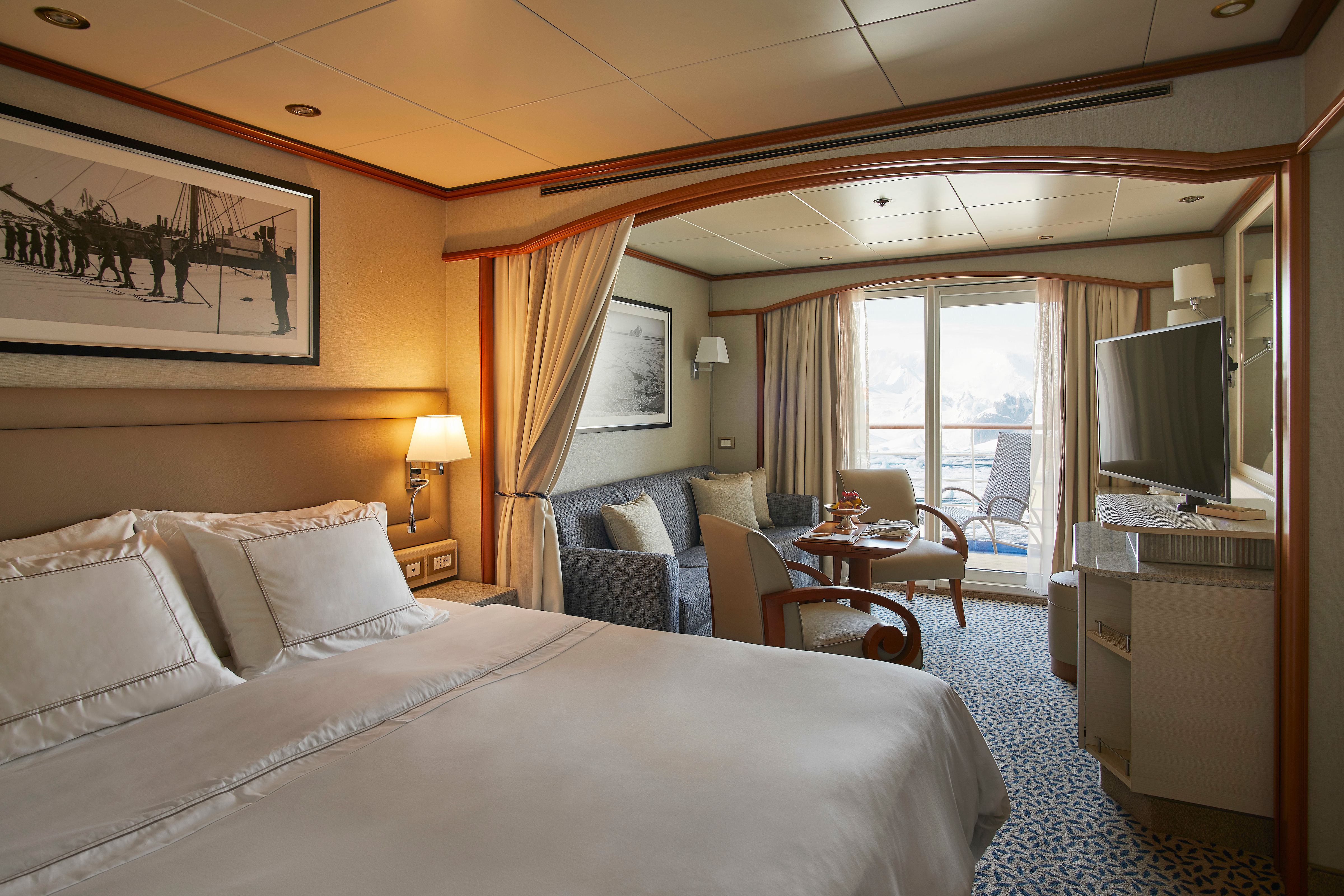
Veranda Suite
A Silversea signature, with a preferred central location, the Veranda Suite is spacious and welcoming. Floor-to-ceiling glass doors open onto a furnished private teak veranda from where you can contemplate anything from the midnight sun to an Antarctic sunrise. The Deluxe Veranda Suite offers a preferred central location with identical accommodation to a Veranda Suite.
One bedroom: 27 sq m including veranda (4.5 sq m)
Two bedrooms: 27 sq m including veranda (4.5 sq m)
Images are intended as a general reference. Features, materials, finishes and layout may be different than shown.
Essentials
- Deck(s): 5, 6, 7
- Section: Aft, Forward
Characteristics
- Veranda
- Sitting area
- Standard vanity
- Separate shower
- Some with full-size bath
- Walk-in wardrobe with personal safe
Furniture
- Queen size bed
- Writing desk
- Luxury bed mattresses
Media & Communication
- Unlimited Standard Wi-Fi
- 1 large flat screen TV with Interactive Media Library
- Direct dial telephone
- Wall mounted USB-C mobile device chargers
- Dual voltage 110/220 outlets
Onboard Services
- Butler service
- Champagne on arrival
Amenities
- Pillow menu
- Refrigerator and bar setup stocked with your preferences
- Plush bathrobe
- Luxury bath amenities
- Umbrella
- Hair Dryer
- Slippers
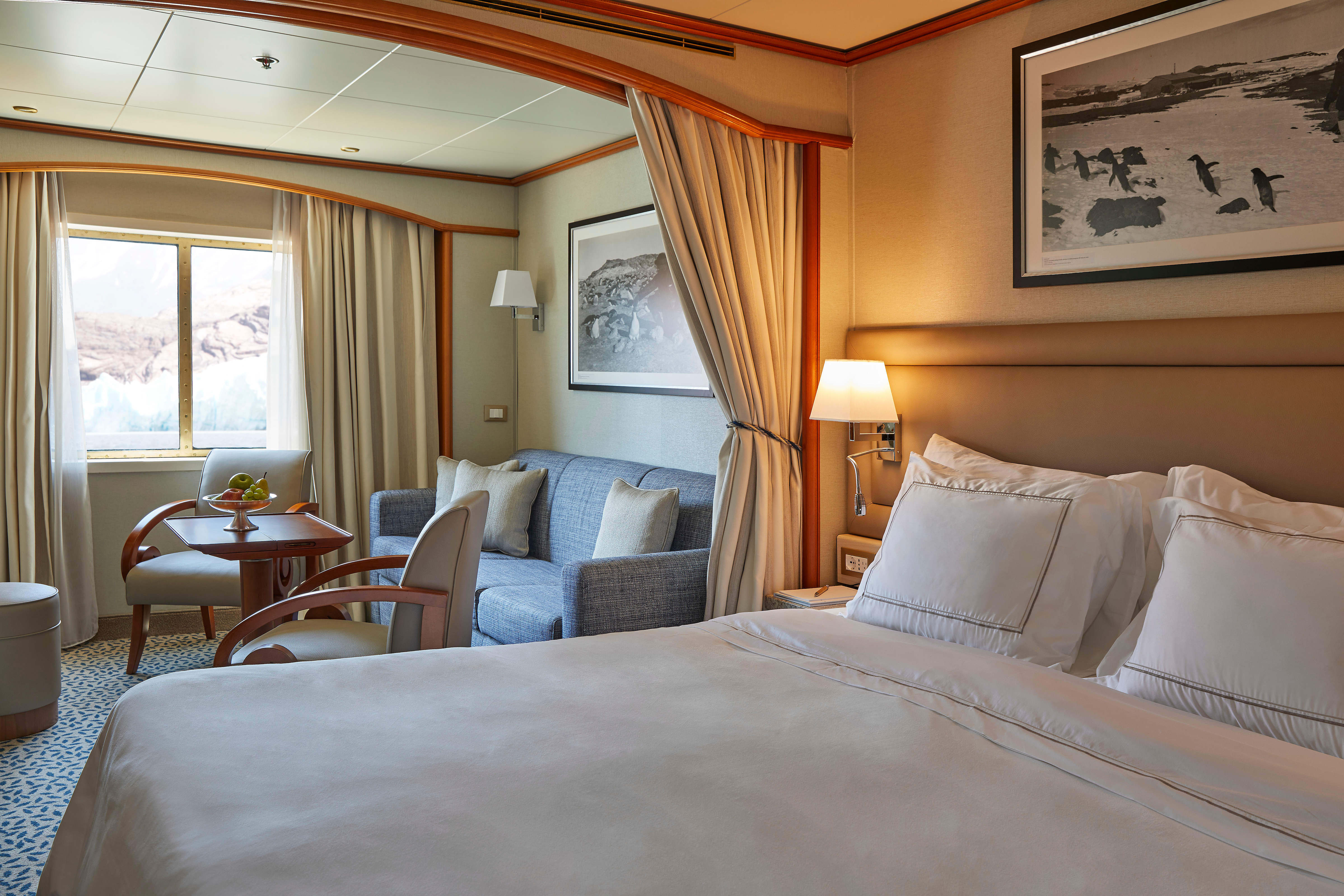
Vista Suite
Your home away from home while you embrace the intrepid explorer within. The suite’s seating area has plenty of room to relax while you go over your notes, ready for the next adventure. Large picture windows frame panoramic ocean views, ideal for appraising the local wildlife.
One bedroom: 22 sq m
Wheelchair accessible suites: 449 and 451
Images are intended as a general reference. Features, materials, finishes and layout may be different than shown.
Essentials
- Deck(s): 4
- Section: Aft, Forward
Characteristics
- Window
- Sitting area
- Standard vanity
- Separate shower
- Some with full-size bath
- Walk-in wardrobe with personal safe
Furniture
- Queen size bed
- Writing desk
- Luxury bed mattresses
Media & Communication
- Unlimited Standard Wi-Fi
- 1 large flat screen TV with Interactive Media Library
- Direct dial telephone
- Wall mounted USB-C mobile device chargers
- Dual voltage 110/220 outlets
Onboard Services
- Butler service
- Champagne on arrival
Amenities
- Pillow menu
- Refrigerator and bar setup stocked with your preferences
- Plush bathrobe
- Luxury bath amenities
- Umbrella
- Hair Dryer
- Slippers

The Grill
Silversea’s much-loved casual dining restaurant serves a delectable range of burgers and salads by day and turns into our famous Hot Rocks table BBQ concept by night. The Grill is quite simply the best place to eat between sea and sky. If you like flavorsome meals cooked to perfection, a casual, laid-back atmosphere, and OMG views, then The Grill is the answer to your prayers.
Dress code: Casual
Casual wear consists of pants, blouses, or casual dresses for women; open-neck shirts and slacks for men are appropriate.
Images are intended as a general reference. Features, materials, finishes and layout may be different than shown.
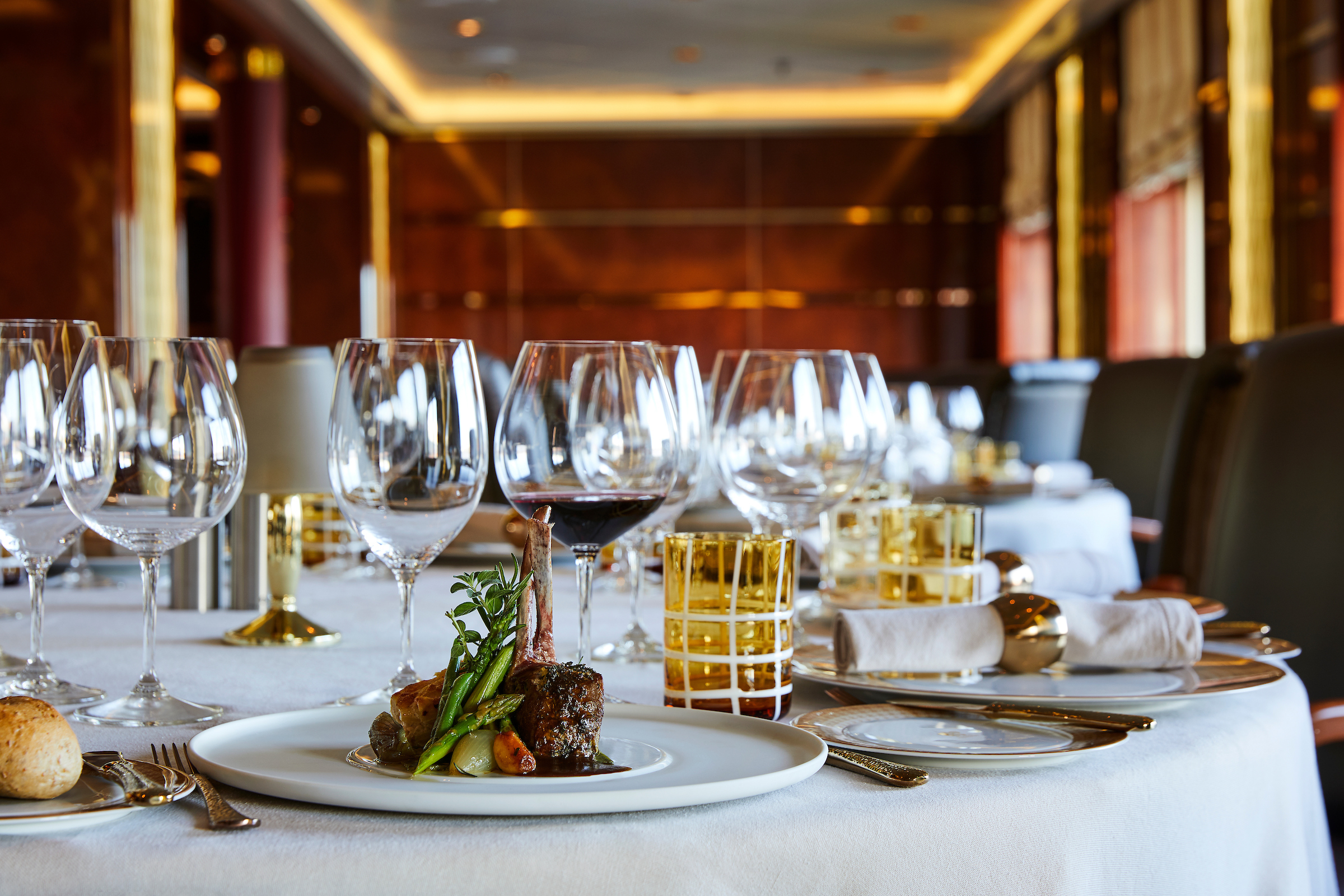
La Dame
After a day of trekking through tundra and whale-watching, indulge in an evening of palette pampering, where fine wines are complemented by a set bespoke menu of regionally inspired dishes in an intimate, elegant setting. An extraordinary six-course experience celebrating the world’s most distinguished wine regions complete what is surely the finest dining at sea.
Per guest reservation fee of US$60. Please visit My Silversea to make your reservations.
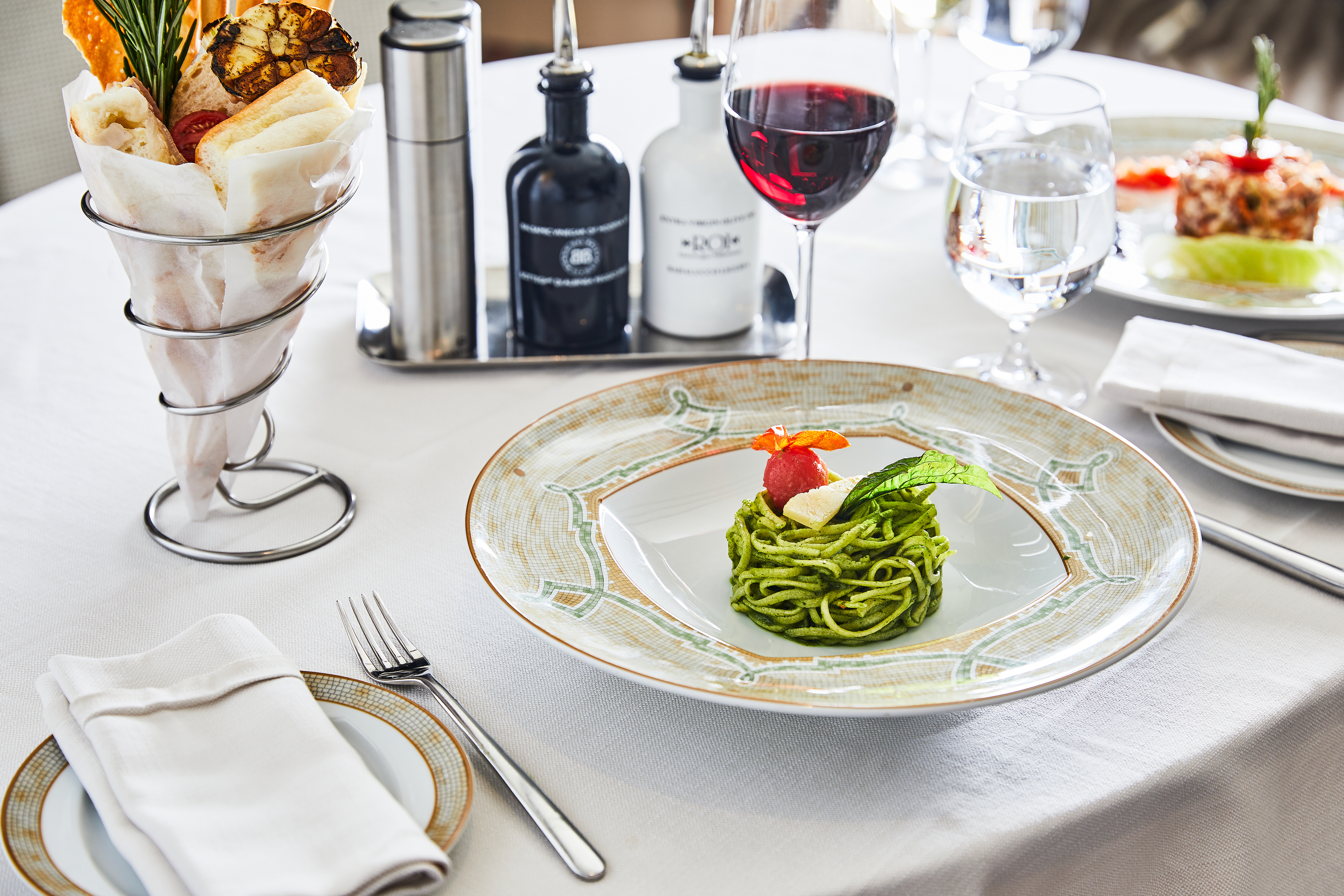
Le Terrazza
La Terrazza is a celebration of the way Italians eat today, an ode to the delicious evolution of the world’s most beloved cuisine. Evolving one of Silversea’s signature restaurants, La Terrazza serves fresh twists on great classics, and also explores the new heroes of Italian cuisine. The notion of comfort traditionally associated with Italian cuisine is present in every dish, every bite, yet always with a subtle element of surprise. La Terrazza is open for casual, buffet-style breakfast and lunch with indoor or alfresco dining on the outdoor terrace. During the evening, the venue transforms into an à la carte Italian restaurant. Seating is limited for dinner and reservations are recommended.
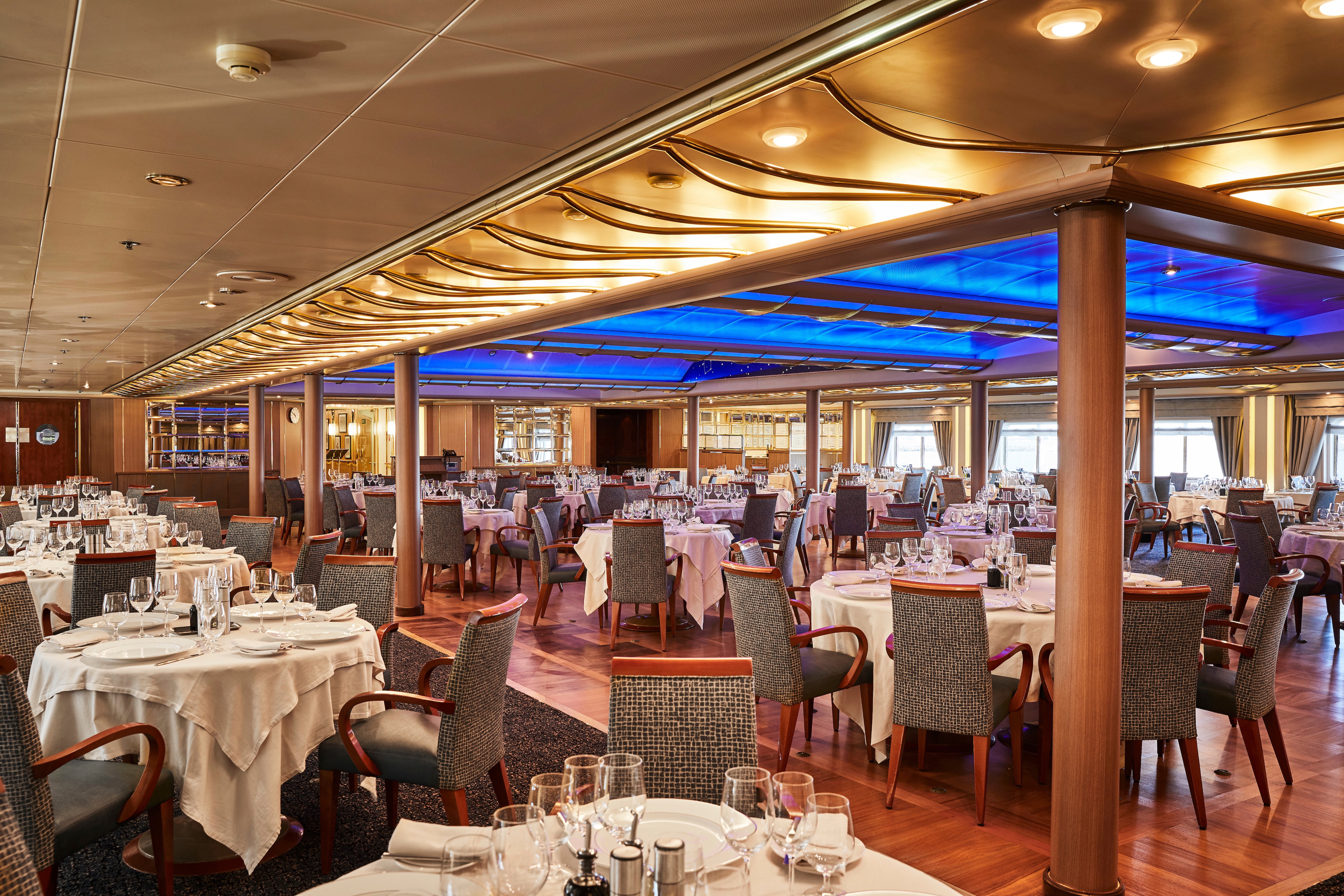
The Restaurant
Sparkling with tales of adventure, bonhomie, and like-minded friends, The Restaurant offers contemporary, international cuisine created by our most talented chefs. Menus feature regional specialties unique to the destinations guests visit on their cruise, so don’t be surprised to see a roasted Chilean Sea Bass while cruising the Chilean fjords.
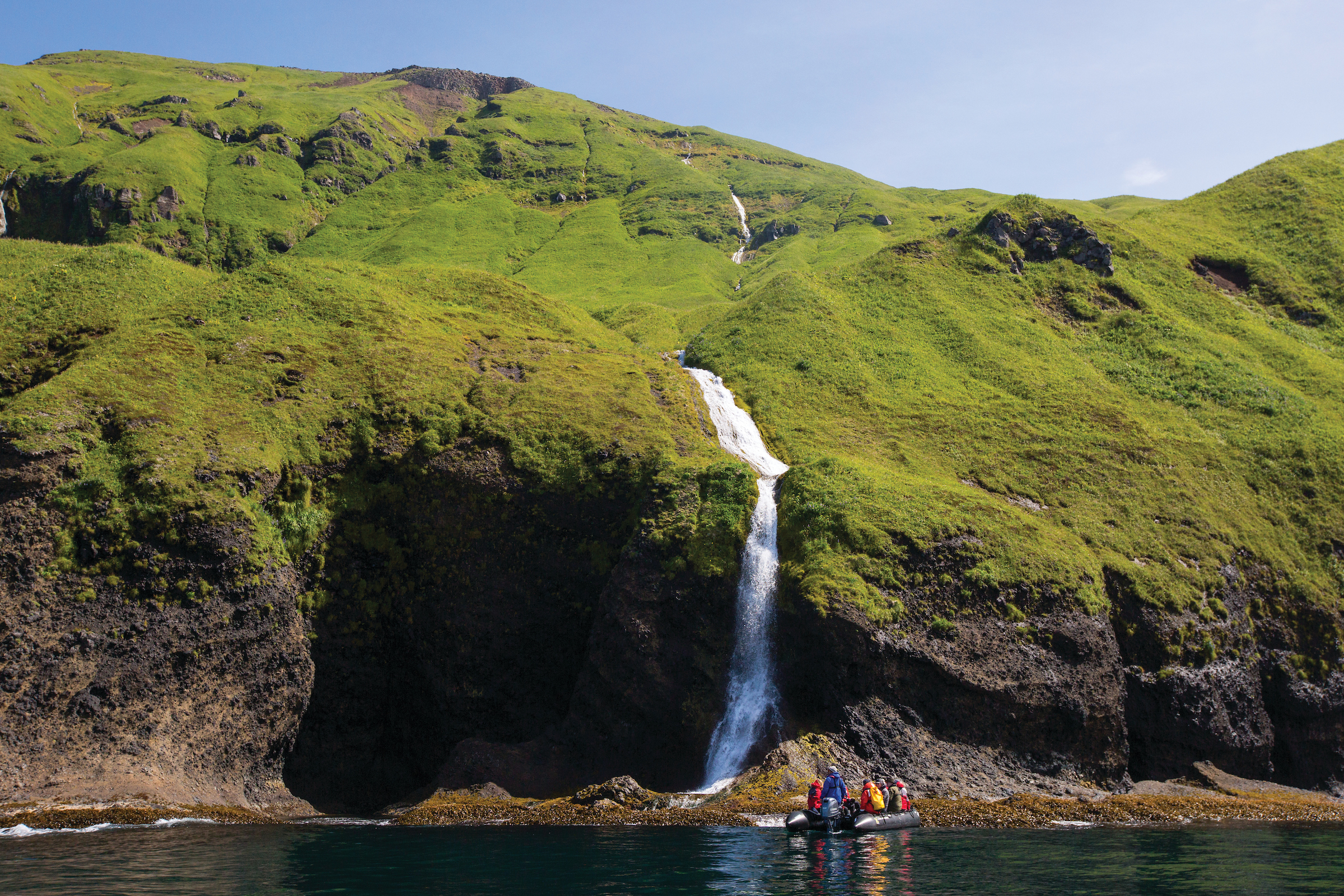
Shore Excursions
Silversea’s experienced Shore Concierge team are happy to assist, ensuring your shore-side experience is nothing less than a memory that lasts forever. Their knowledge and understanding of ports will truly add to your enjoyment and experience. Detailing history, local flavor, culture, regional customs, shopping tips and much more, they will make sure you experience the best your destination has to offer, wherever you are in the world.
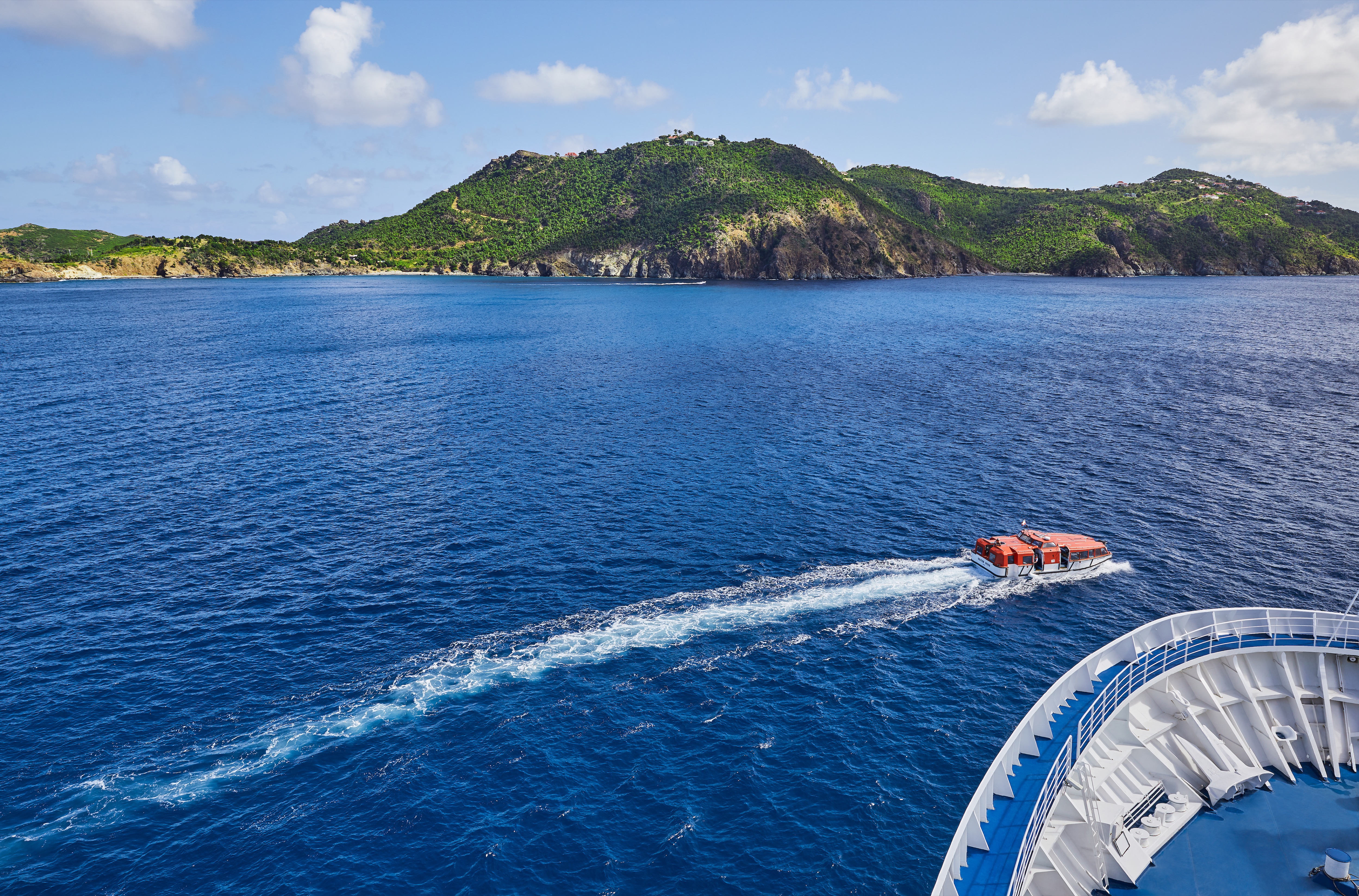
Mid-Voyage Adventures
Multiple days at sea mean plenty of R&R for some, but others prefer to experience all there is to offer on land. Our Mid-Cruise Land Adventures allow you to take full advantage of your time with us without missing a single thing! These short escapades offer an array of adventures, break up your sea days and allow for deeper exploration beyond the coast.
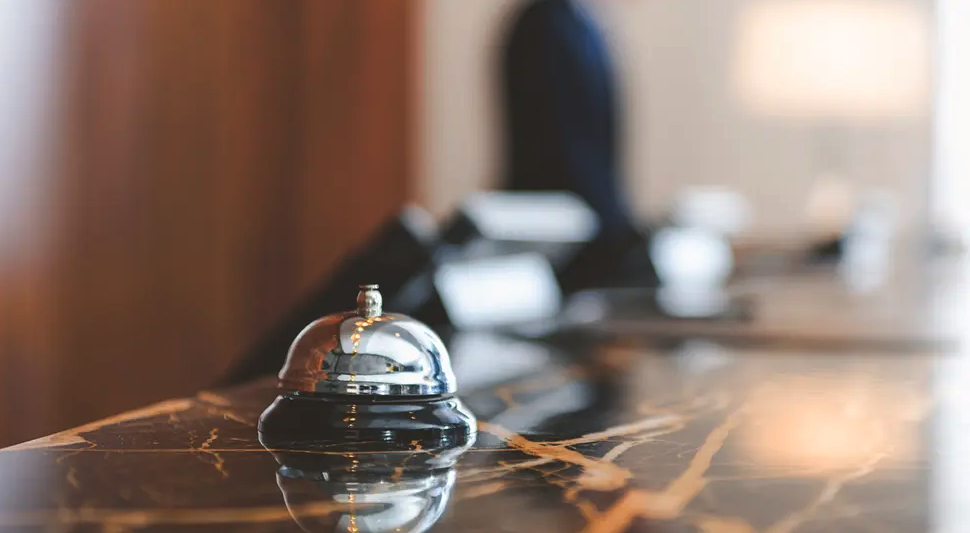
Silver Shore Concierge
Let Silversea customize a special event or excursion exclusively for you. Expert Shore Excursion professionals are available to assist with all your Shorex questions. Make an appointment and gain insider access to knowledgeable suggestions, personalized planning and hassle-free coordination of all private, independent touring, including area highlights, flightseeing, water sports, and much more. Take advantage of this service either in advance of your voyage by email at shoreconcierge@silversea.com or on board by visiting the Silvershore® Concierge desk. Have the Silver Shore Concierge create your tailor-made tour, or be whisked away by private car for a day—the pace and agenda are up to you.
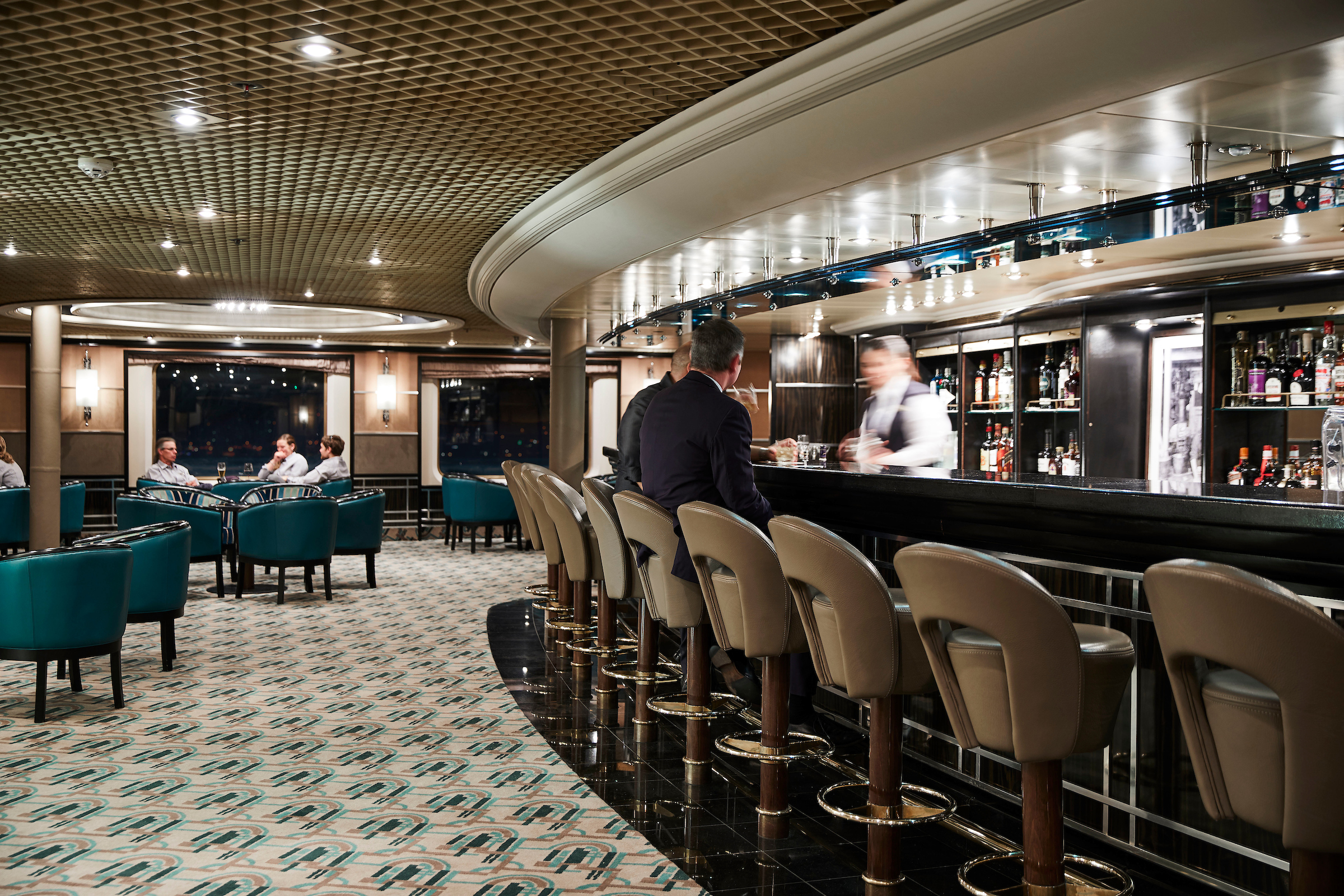
Dolce Vita
With complimentary cocktails and engaging conversation, live music, and a dance floor, Dolce Vita on board Silver Cloud welcomes guests to mix and mingle. When living such unique experiences as these, there is never a dull moment!
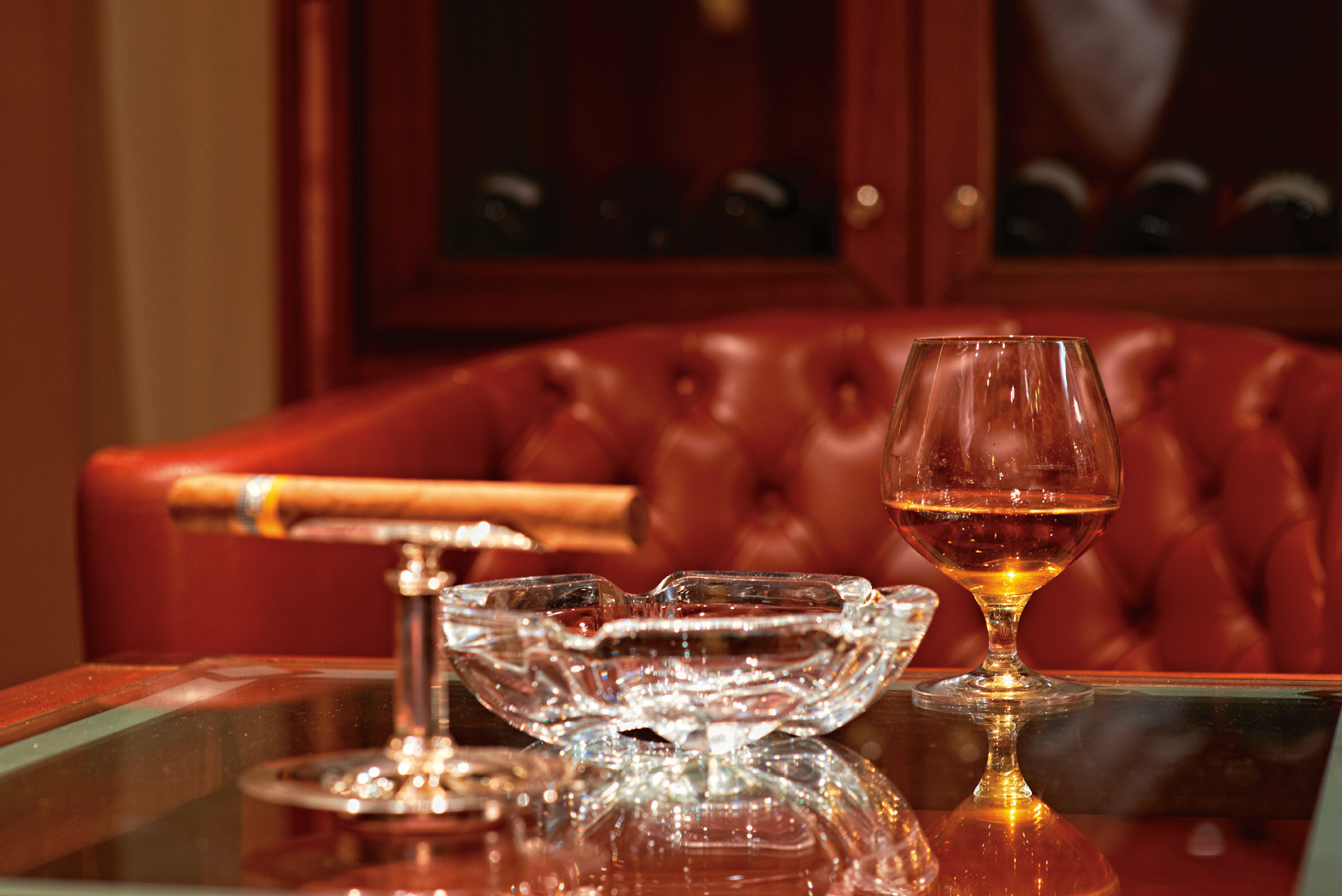
Connoisseur's Corner
The Connoisseur’s Corner offers exceptional cognacs along with a premium selection of cigars for purchase.
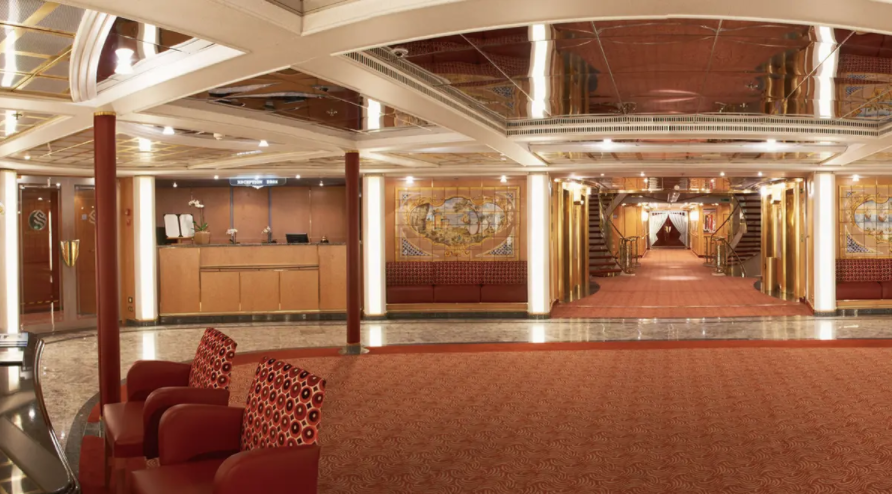
Reception
This central lobby area welcomes guests to speak with our receptionist if they have a question or require any service. Assistance is available 24 hours a day. The Cruise Consultant may also be indispensable when planning your next Silversea voyage, or if you wish to extend your current voyage for a day, a week, a month … Like having your own personal onboard Silversea professional, the Cruise Consultant will help you to select the perfect voyage, reserve your preferred suite, and provide immediate confirmation.
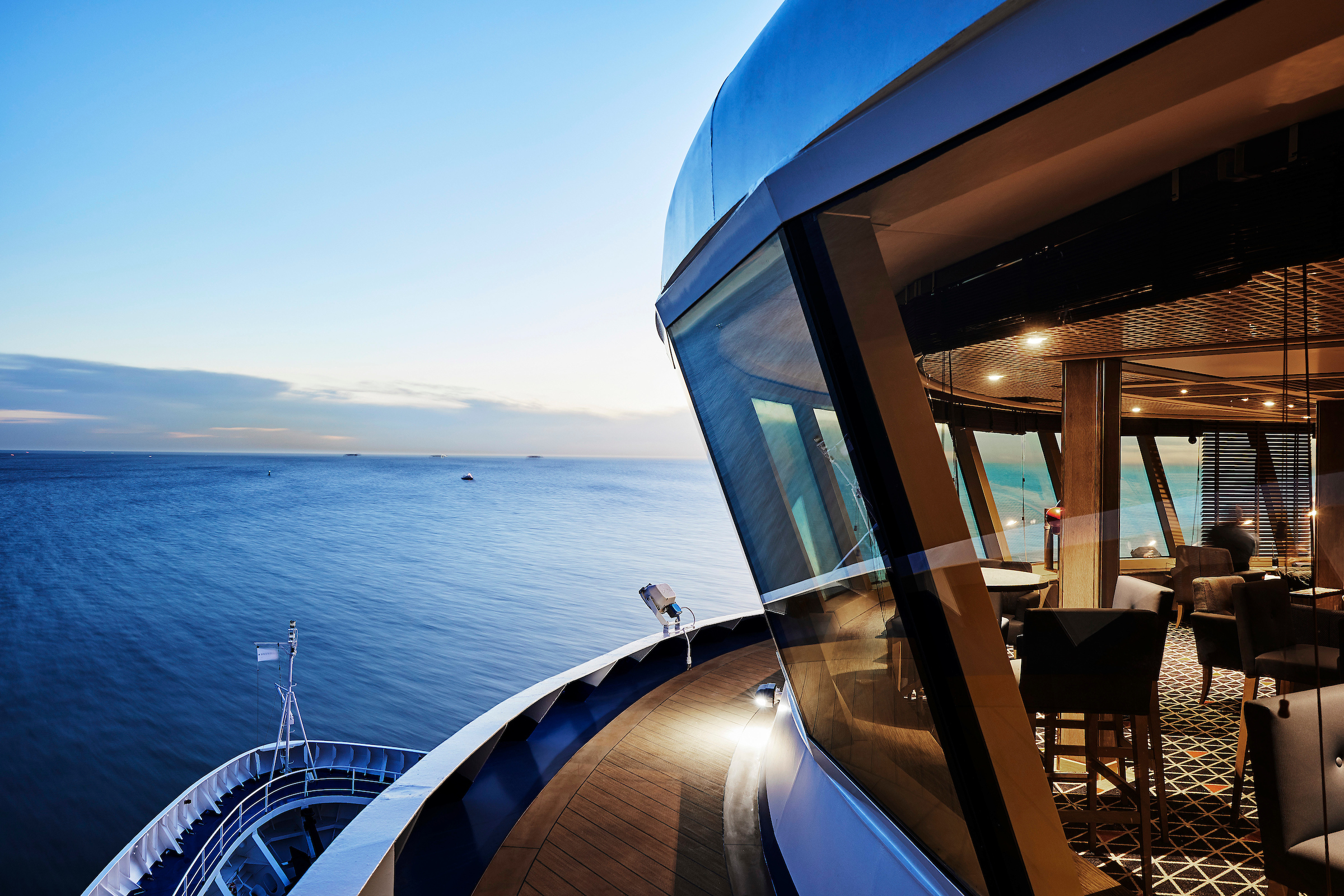
Observation Lounge
The ideal place for scenic days at sea, this vantage point far forward and high atop this luxury cruise ship is perfect for that “king of the world” feeling.
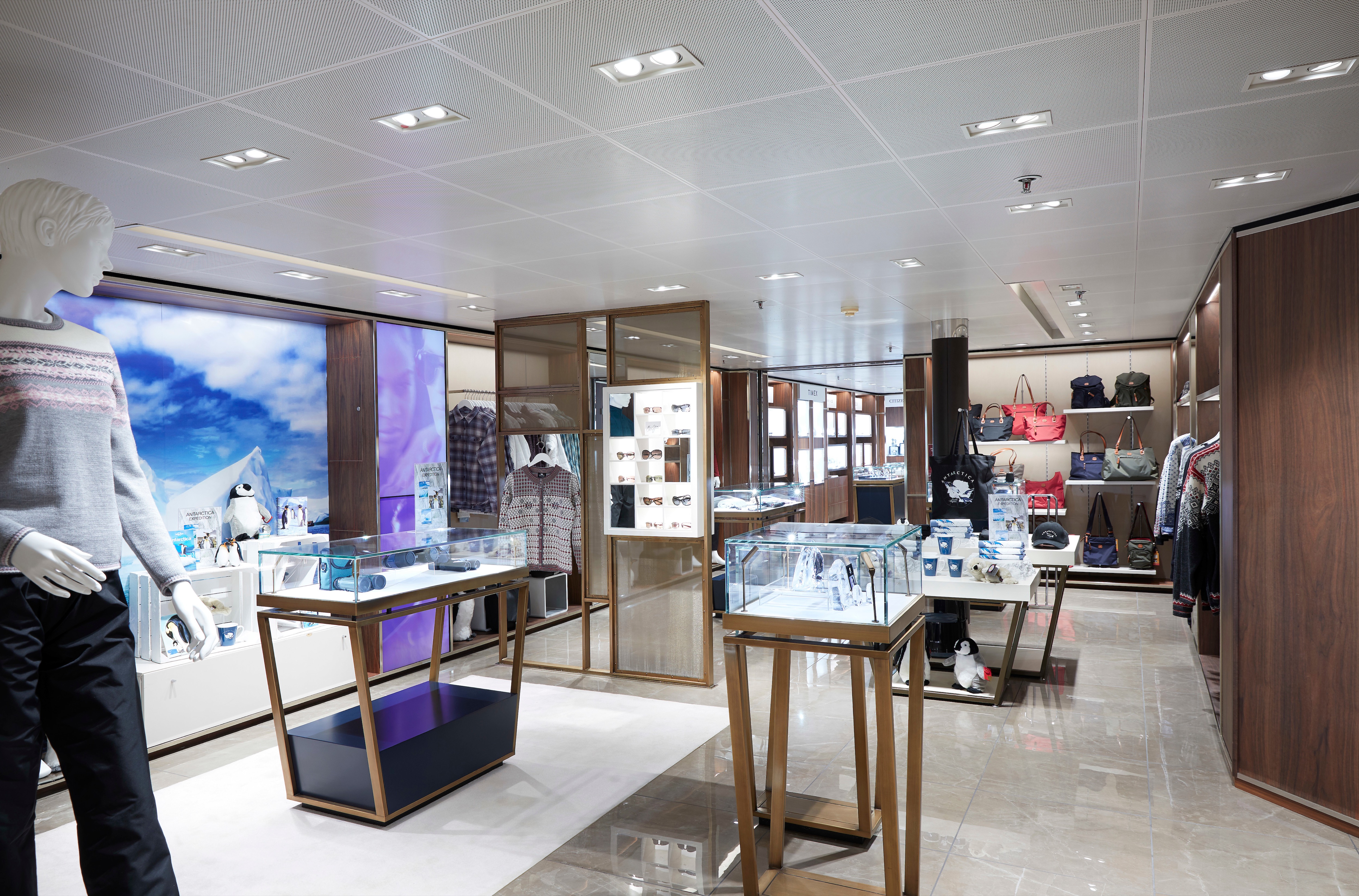
Boutique
Exceptional shopping experiences do not end in the cosmopolitan cities we visit. Silversea’s striking new shipboard boutiques, reimagined and redesigned, are stunning modern design spaces befitting the finest creations from legendary designers. Carefully selected partners on board Silversea’s duty-free boutiques offer our guests a carefully curated selection of cutting-edge fashions, jewelry, accessories, fine perfumes, cosmetics, and Silversea Logo collection, all at duty-free prices.
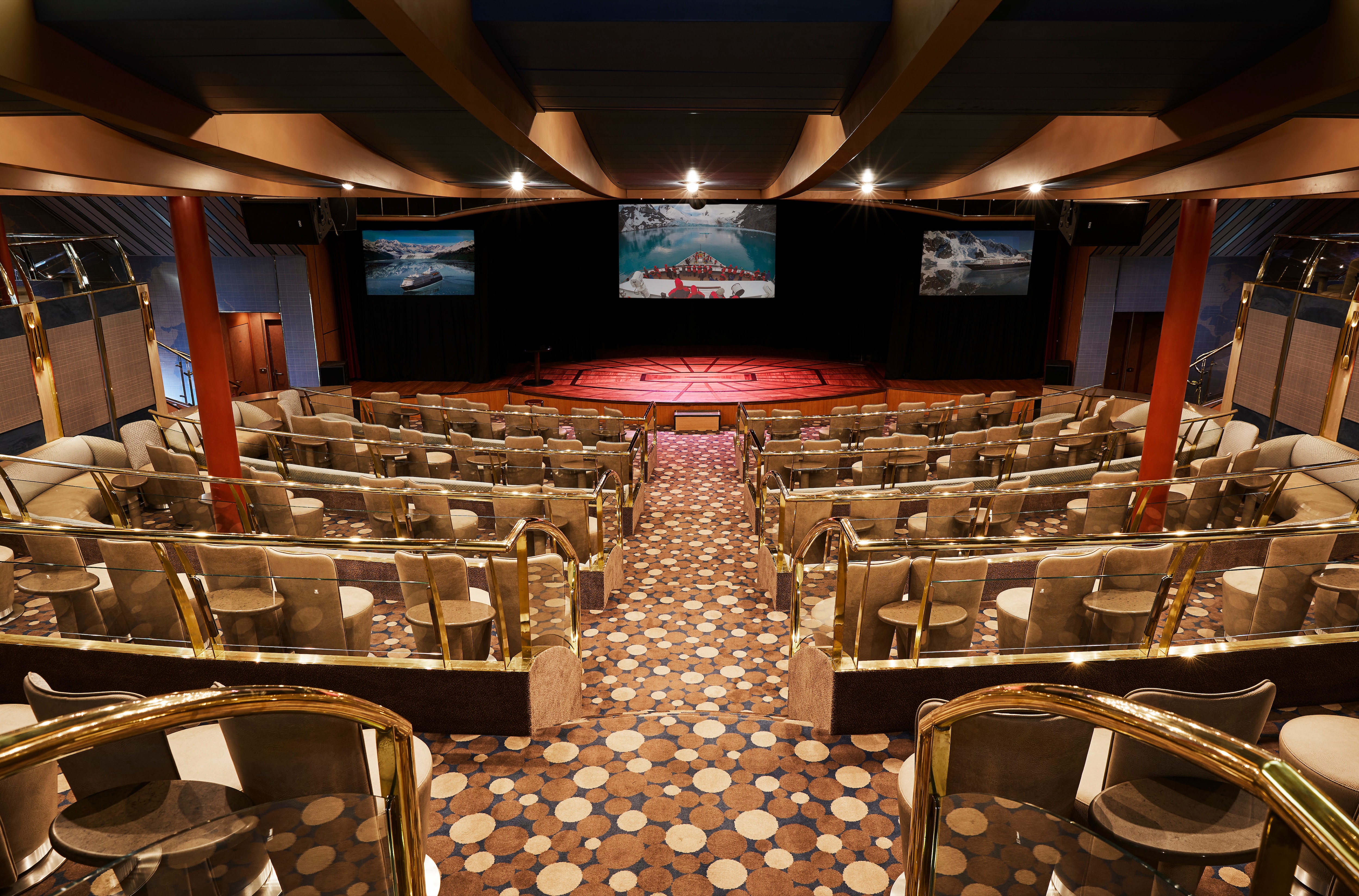
Explorer Lounge
Perfect for presentations, lectures, and video screenings, this is where our team of dedicated experts share their knowledge on their specialized subject, not to mention their infectious passion and energy. The multitiered Explorer Lounge and banquette-style seating ensure that you enjoy every minute of the talk, with lectures streamed live to your suite if desired. This is one of the very few lecture theaters at sea to combine such comfort with such technology.

Panorama Lounge
The Panorama Lounge is specially designed to provide an uninterrupted view of the day’s destination from the comfort of the luxury cruise ship’s interior. This is an ideal place to unwind on your cruise, enjoy afternoon tea, listen to the pianist, and watch the setting sun. The drinks are complimentary, and the music is live and inviting. Enjoy dancing to a range of musical styles for every taste, from the classics to the latest club mixes.
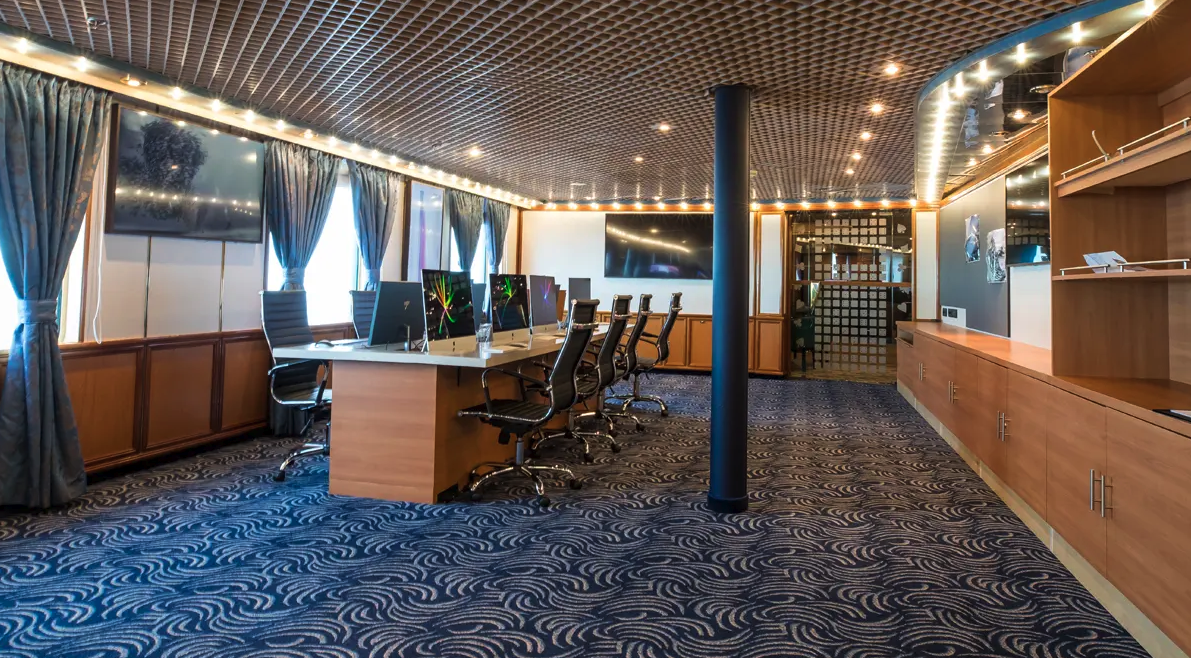
Photo Studio
The Photo Studio offers a multitude of options to take your pictures from your camera to your walls. A vibrant, creatively inspiring space where you can not only master the art of digital photography with master classes in editing and Adobe Lightroom and Photoshop, but also an editing suite where you can print images (including postcard, panorama, and A2-sized prints). State-of-the-art equipment for both Mac and PC users, highly technological printers, plus a dedicated photo manager to guide you through the many techniques to help you define yourself as a serious photographer. Even the smartphone photographer can become pro-level with specialized training on how to use your camera phone to its best possible advantage. Fees apply.
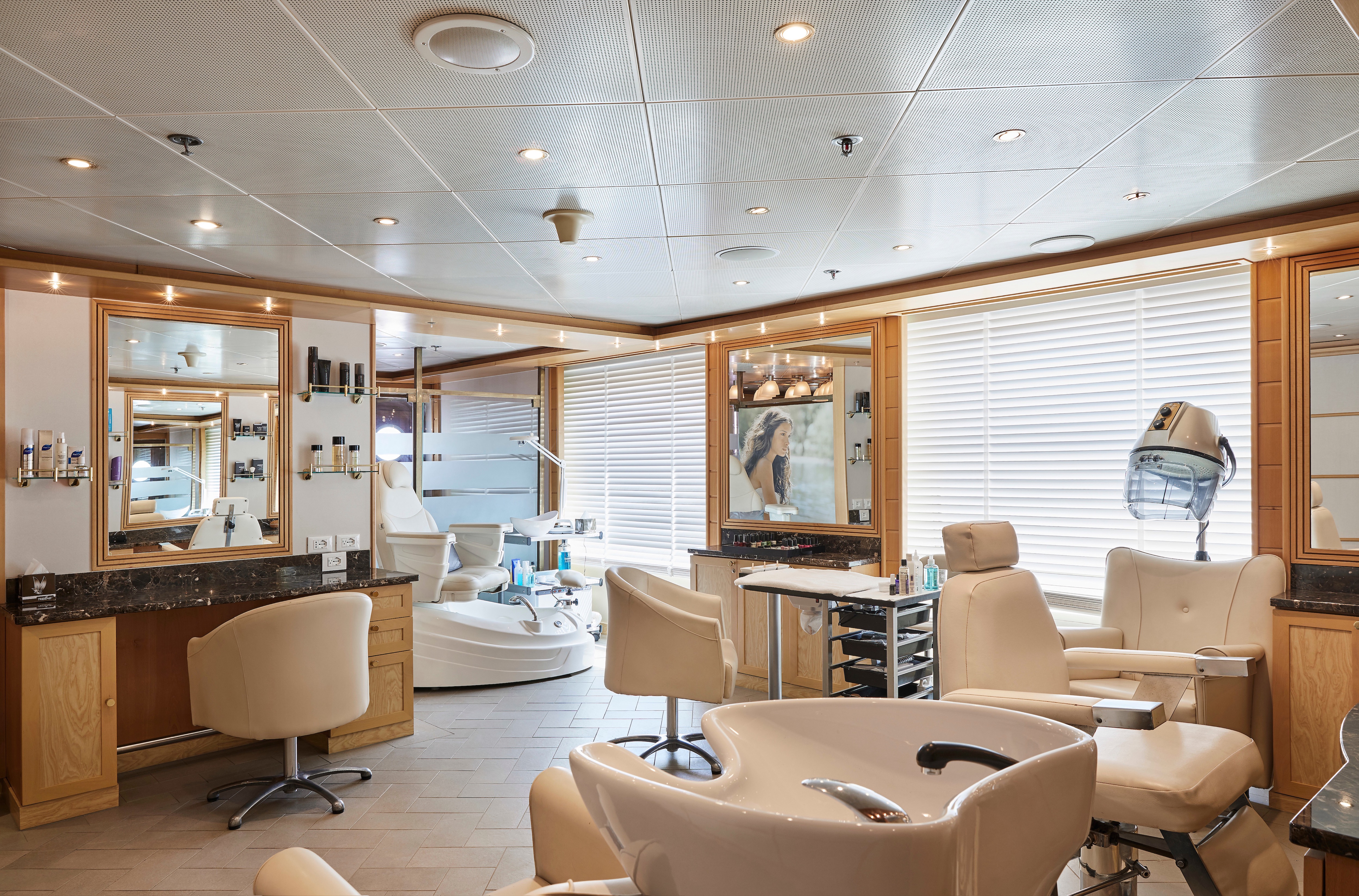
Zagara Beauty Salon
A full range of Zagara Beauty Salon services is available for both men and women including hairstyling, manicures, and pedicures. Appointments for these chargeable services may be made on board the ship.
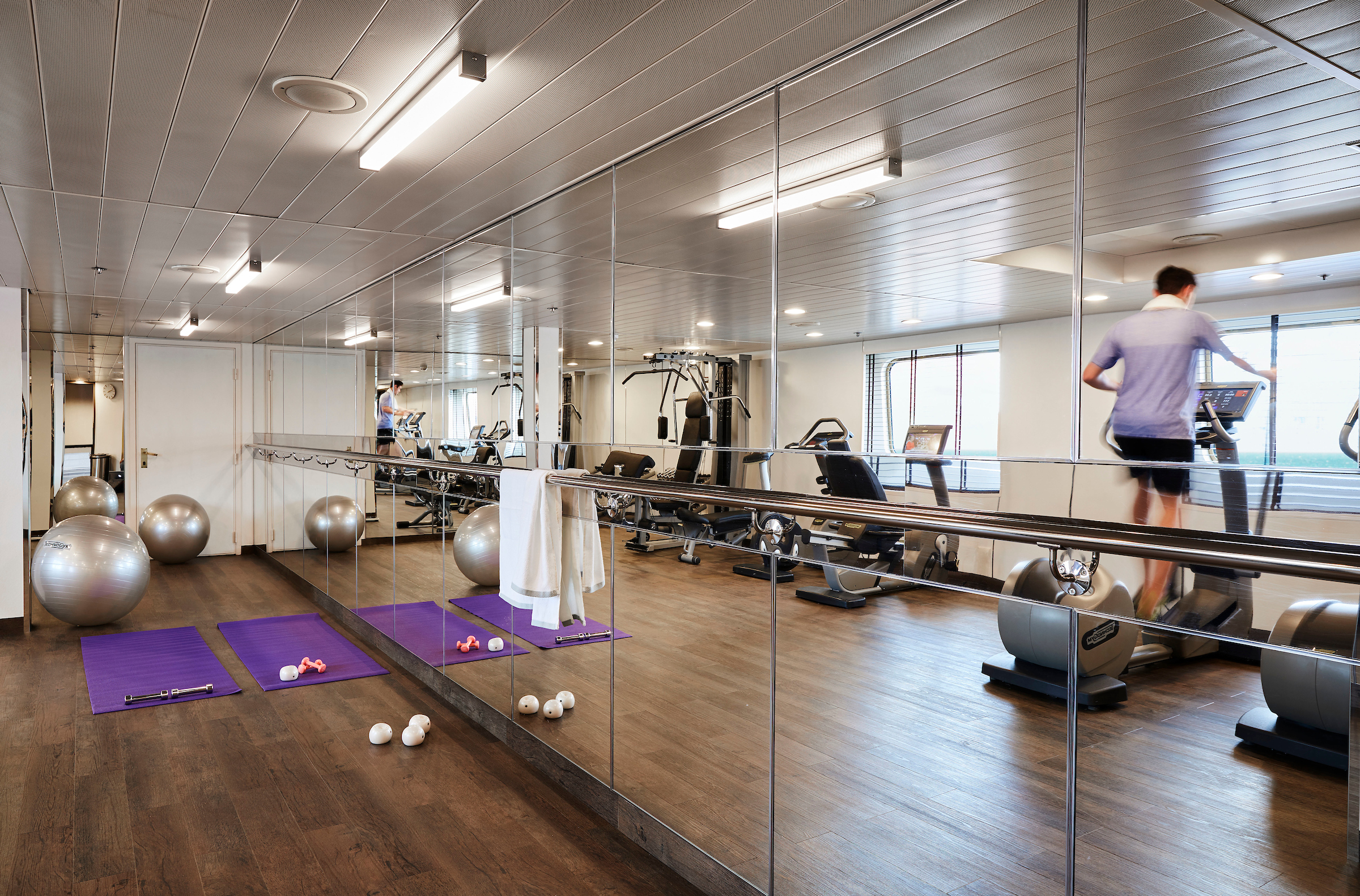
Fitness Centre
The Fitness Center on board this luxury cruise ship is equipped with free weights, weight machines, state-of-the-art treadmills, elliptical trainers, and recumbent and upright bicycles. Classes in aerobics, yoga, Pilates, and circuit training are led by the onboard fitness trainer and are always complimentary. Personal training, body composition analysis, and specialty classes are available at an additional charge on board all luxury cruises.
Images are intended as a general reference. Features, materials, finishes and layout may be different than shown.
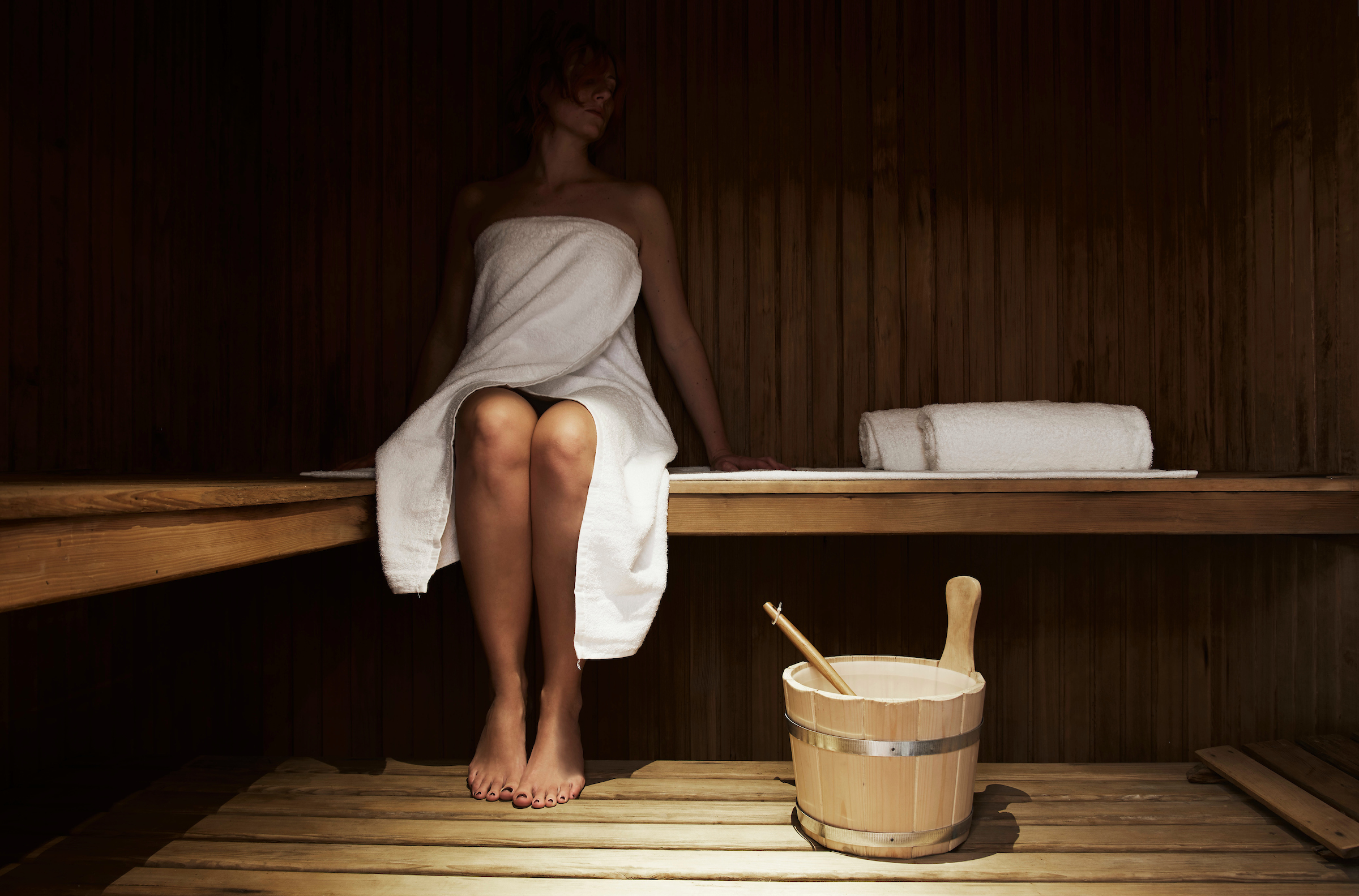
Zagara Beauty Spa
Relax your body and mind in this luxury cruise ship’s soothing spa sanctuary. Indulge in a wide range of invigorating therapies, including facials, body wraps, and massages. Appointments for spa services may be made on board the ship, or in advance via My Voyage. Men’s and women’s saunas and steam rooms are perfect for relaxing before your spa treatment or after your workout.

Pool Deck
Chaise lounges arranged in the sun or shade. Bubbling whirlpools. The pool water is refreshing in warmer climates and heated for cooler weather. Attentive staff is at the ready with an oversize towel as you emerge from the pool, with your favorite beverage at just the right moment. This is expedition cruising as you have never experienced it before. What better way to watch the icebergs?

Jogging Track
A jogging track is available for guests, running the entire outside edge of the deck.
Dress Code
How many formal nights are on my cruise, and what type of clothing is worn?
Find out what to pack. All the details are shown in the General Information section. For Silversea Expeditions guests, casual resort wear is appropriate at all times when on board, with the exception of two evenings when formal attire is required. For men, this means a jacket, tie optional.
Does Silversea offer tuxedo rental service?
No, however, the onboard boutique has a limited selection of formal wear attire for purchase.
Smoking Policy
At Silversea, the comfort, enjoyment and safety of all guests is paramount. To ensure a pleasant and safe environment, smoking is prohibited in most public areas, guest suites or suite balconies. However, cigarette, e-cigarette, cigar, pipe and vaporizer smoking is permitted in the Connoisseur’s Corner both indoors and outdoors (where applicable). In addition, cigarette, e-cigarette and vaporizer smoking is permitted in specifically designated outside areas and tables:
- Silver Nova, Silver Ray: Dusk Bar (port side);
- Silver Muse, Silver Spirit: Panorama Lounge (port side) and Pool Grill (port side);
- Silver Moon, Silver Dawn: Panorama Lounge (starboard side) and Pool Grill (port side);
- Silver Shadow, Silver Whisper: Panorama Lounge (starboard side) and Pool Grill (starboard side);
- Silver Cloud, Silver Wind: Panorama Lounge (port side) and Pool Grill (port side);
- Silver Origin: on open deck 4 aft;
Silversea kindly requests that all guests observe the non-smoking areas.
Disabled Facilities
Wheelchair guests must bring their own collapsible wheelchair. Please note that not all shore excursions are suitable for guests with impaired mobility. Silversea strongly recommends wheelchair guests travel with someone who is able to assist them both ashore and at sea as Silversea may be unable to offer special assistance. Please note that wheel-on and/or wheel-off access may not be available at some ports-of-call. Silversea reserves the right to deny boarding to any guest who failed to notify Silversea of such requirement at the time of booking.
Silversea welcomes guests with mobility needs and offers various accessibility features onboard. However, due to the nature of cruising, some destinations and excursions may present challenges. Below is a guide to help guests plan their journey.
BEFORE BOOKING
Do guests need to notify Silversea in advance about mobility needs?
Yes, guests should inform Silversea of any special assistance or mobility equipment requirements before sailing. This can be done via My Silversea under Guest Information / Special Request, or by contacting specialservices@silversea.com.
Does Silversea provide wheelchairs?
Yes, each vessel has wheelchairs available at the reception for temporary use, such as embarkation and disembarkation. Guests who require a wheelchair for the entire cruise should bring their own.
Can guests bring their own mobility equipment?
Yes, personal wheelchairs, scooters, and other mobility aids are allowed. However, guests staying in standard (non-ADA) suites should note that electric scooters may not fit through the doors.
Therefore, guests traveling with a wheelchair, scooter, or ECV are always highly suggested to book a wheelchair-accessible suite with a wider entrance door and an appropriate path of travel inside the room and accommodate the equipment. Regular Suites have a narrower entrance door and may not have the necessary interior space to accommodate wheelchairs and scooters.
What features do wheelchair-accessible suites offer?
Silversea ships offer specially designed suites for guests who require mobility assistance. These suites are equipped with wider entrance doors and appropriate paths of travel to accommodate wheelchairs, scooters, and other mobility equipment. All areas within these suites are reachable without the need for additional ramps, except for Silver Suites onboard Silver Moon and Silver Dawn and Classic Veranda onboard Silver Endeavour. In these suites Silversea offer ramp to go outside the balcony. The vessels also have wheelchairs available at the reception for guest use.
Where to find the information regarding the disabled access suites?
This information is visible under the Suite tab by suite category.
Also, can be found on the deck plan after clicking on the “View Deck Plan” tab on the ship page. The disabled access suites are indicated with the universal accessibility icon.
EMBARKATION & DISEMBARKATION
How do guests get on and off the ship with mobility equipment?
Silversea vessels have procedures in place to assist guests with mobility equipment during embarkation and disembarkation. When the gangway is flat, guests can drive their wheelchair off the ship. However, if the gangway involves stairs, our staff will provide assistance. The Safety Officer or Bridge must be informed whenever a wheelchair is involved in disembarkation or boarding, and our crew members are available to assist guests in need.
Is assistance available for boarding?
Yes, but guests who require full-time assistance should travel with a companion, as Silversea does not provide dedicated personal caregivers. Butlers can assist with getting to the gangway or dining venues but do not provide continuous mobility assistance.
ONBOARD
Silversea’s ships are designed for accessibility, featuring:
- Wide gangways to accommodate most wheelchairs and scooters
- Accessible public restrooms
- Wheelchair seating in dining venues, bars, and the Venetian Lounge
- Braille/tactile signage for visually impaired guests in elevators, stateroom numbers, and staircases
How does Silversea assist disabled guests in their suites?
Silversea butler can provide reasonable assistance to guest getting to and from the gangway, and to and from a restaurant, however Silversea does not offer full-time wheelchair service and/or staff fully dedicated to providing Guests with wheelchair assistance. Guests traveling on their own wheelchair should be assisted only when requested and are recommended to travel with an able bodily companion.
GOING ASHORE
Are all ports wheelchair accessible?
Not all ports have wheelchair-friendly infrastructure. In some destinations, tender boats or on Silversea Expeditions Zodiacs are required for disembarkation, and wheelchairs or mobility scooters cannot be accommodated in these cases.
Can guests arrange private accessible transportation in port?
If available, private wheelchair-accessible vehicles can be arranged. In some ports, shuttle buses may be wheelchair accessible, but availability is not guaranteed.
Does Silversea offer wheelchair-accessible shore excursions?
Until now we have been offering dedicated “Wheelchair Accessible Excursions” in some areas of the world., These tours are operated by wheelchair accessible vehicles and include only wheelchair accessible venues. These tours are mainly offered in Europe and the US. If you have any questions or concerns regarding shore excursion suitability, please contact the Shore Concierge (shoreconcierge@silversea.com) before your voyage or visit the Shore Concierge desk for more detailed information once onboard.
Wheelchair accessible shore excursions are indicated on the website with the universal accessibility icon.
Are there alternatives for guests with limited mobility?
In almost every port, Silversea offers low-activity excursions specially designed for mobility challenged guests, who can negotiate the steps on and off the coaches.
Is there any destination that is not recommend to guests with disabilities?
The more exotic destinations, like Asia, South Africa and South America it is recommended to guest to book a private vehicle due to the lack of infrastructure, for example wheelchair accessible vehicles are very rare to find and museums, restaurants and popular attractions are not often completely accessible.
Does Silversea offer wheelchair-accessible transportation between the ship and visiting site?
If available in the port yes, however this is not often available.
How Silversea assist disabled guests during excursions?
If wheelchair accessible excursions are not available, it is recommended to guests to book a private vehicle where they can have a dedicated guide and driver who can give them full attention. On regular shore excursions, the guide must look after all guests and may not be able to fully assist disabled guests.
Special Dietary Requirements
If you have special dietary requirements, Silversea will make every attempt to accommodate your requests. Please advise Silversea of your needs on the Guest Information Form at least 75 days prior to sailing. Notification should be sent to specialservices@silversea.com
Medical Centre
Each Silversea ship is equipped with a Medical Centre, which is staffed by a doctor and nurse on 24-hour call when at sea. When docked, supplementary emergency care may also be obtained through local medical facilities. Guests may be charged for medical services and for medications used for their medical treatment. The Medical Centre is not intended or designed to provide on-going treatment of pre-existing conditions or for extended critical care, and Silversea is not responsible for the diagnosis, treatment or services furnished by shipboard medical personnel.
All guests are required to report in writing to Silversea at the time their reservation is made:
- Any physical or mental condition that may require medical or professional treatment or attention during the voyage
- Any condition that may render the guest unfit for travel, or that may require special care or assistance
- Any condition that may pose a risk or danger to the guest or anyone else on board the ship
- Any condition that may require oxygen for medical reasons
- Any intention or need to use a wheelchair aboard ship.
Age Restrictions
Silversea cruise guidelines state that children under the age of 18 must be accompanied, in the same or connecting suite, by a parent or other responsible adult over the age of 21 for the duration of the voyage. If the adult accompanying the minor is not their parent, a parental consent guardianship form must be signed by a parent or legal guardian and received by Silversea prior to sailing. Please contact our Special Services Department at SpecialServices@Silversea.com for a Parental Consent Form. Guests must be 21 years of age or older to purchase or consume alcohol. Silversea reserves the right to refuse to serve anyone who in its sole judgment may be under the influence of alcohol, or for any reason necessary in its judgement to preserve the health and safety of guests and employees.
Silversea cannot accommodate infants less than six months of age and reserves the right to limit the number of children less than three years of age (Silver Explorer, Silver Cloud and Silver Wind cannot accommodate infants under the age of 1 year, Silver Origin cannot accommodate children under the age of 5 years). Parents are required to sign a notarised waiver prior to sailing in order to grant a valid booking for children ages between 6 months and 1 year old. A signed and notarised waiver will be required for all children between these ages. Although Silversea accepts guests over the age of 6 months (over the age of 1 year for Silversea Expeditions), there are no special programmes for children on board our luxury cruise ships, and Silversea does not provide for the care, entertainment or supervision of children. Silversea reserves the right to limit the number of children less than 3 years of age.
Children under the age of 8 years old are only permitted to participate in suitable Silver Shore Excursions / shuttle service if the vehicles are equipped with the correct safety harness and seating equipment. Child harnesses and secure seating cannot be guaranteed. Silversea reserves the right to refuse children under the age of 8 years old on any tour on the basis of safety. Guests may use their own approved safety seat, booster seat or harness provided they are compatible with the local touring vehicle and can properly secure the child.
In addition, the Zodiacs used for Silversea Expeditions are unable to accommodate children younger than 5 years of age. As Silversea does not provide babysitting services, an adult family member will be required to remain on board with their child(ren) during Zodiac excursions.
Laundry Service
Complete valet services, including laundry, pressing and wet cleaning, are available at an additional charge and may be arranged through your butler. Laundry service is complimentary on higher category suites (Premium Medallion, Medallion, Silver, Royal, Grand, Junior Grand, Signature, Master, Otium and Owner’s Suites) and for those Venetian Society members who have reached certain reward levels. click here to learn more. A self-service laundromat offers washing machines, dryers, irons and laundry supplies, allowing you to limit the amount of cruise luggage needed, especially for longer voyages.
Wi-FI & Internet
All Silversea ships are equipped to offer wireless (Wi-Fi) Internet access. You can use your own laptop to surf the Internet and check emails at Wi-Fi locations throughout the ship, or from the comfort and privacy of your suite. Computers, email and Internet access are also available on board at the Internet Café. However, it is important to understand that telecommunication services while at sea are via satellite and significantly different than high-speed connections on land back home. The signal travels in a similar manner to radio waves but at much greater distances. Therefore, onboard Internet access is not guaranteed at all times. Satellite communications are also affected by weather and the ship’s location. In particular, Internet service is extremely sporadic while in the Arctic. Guests aboard expedition cruises to/from Svalbard should be prepared to be out of communication for the duration of their time on board.
Onboard cell phone service enables you to make and receive phone calls, text messages and other select data services on your cell phone even when miles away from land. Your cell phone service provider will bill you for calls and/or messages, which may appear as roaming charges. Please note that cell phone service is sporadic at best while in the Arctic. Guests aboard voyages to/from Svalbard should be prepared to be out of communication for the duration of their time on board. Click here for more information on Silversea’s Cellular Phone service.
Will my devices work on board?
To be most successful, prepare your devices BEFORE leaving home:
- Learn how to turn ON and turn OFF both the Wi-Fi and network (mobile/cellular) connections on each of your devices.
- Contact your mobile/cellular service provider to confirm that a roaming agreement with Silversea Cruises has been established and to ask about rates. Learn how to enable your international roaming
- Set up an email account if you do not have one already.
- Be sure you know any usernames and passwords you may need.
- Switch your settings to the most basic choice that shows less graphics and loads faster.
- Make any software updates and turn off any automatic update settings for the duration of your cruise.
- Download any books, audiobooks, music, movies, games, apps, etc. that you may want during your cruise.
- Facebook users should bookmark and plan to use M.Facebook.com or Touch.Facebook.com instead as these have less graphics and load faster.
- Don’t forget to pack any power cords/battery packs, camera cables to transfer pictures, adapter cables and headphones you may need for each of your devices.
Will I be able to download videos and stream music?
Certain websites and services may be restricted due to limited bandwidth. Downloading videos, books and movies or using Skype are examples of high-bandwidth services that will be more frustrating than enjoyable and should be avoided. Plan to use the Internet only for emailing and web browsing.
How can someone contact me on the ship?
In the case of an emergency back home, friends and family should not call your cell phone. The Shore-to-Ship number provided in your Final Cruise Documents is the best way to reach you while aboard ship. Click here for more information on Dial A Ship service, an alternate option for contacting ships at sea, anywhere in the world.

Deck 9
- Observation Lounge
- Zodiacs
- Jogging Track
- Open view to Swimming Pool

Deck 8
- Pool
- Pool Bar
- Pool Grill
- The Grill
- Panorama Lounge
- Connoisseurs’s Corner

Deck 7
- La Terrazza
- Zagara Beauty Spa
- Library
- Medallion Suite
- Silver Suites
- Veranda Suites
- Owners Suites
- Grand Suites

Deck 6
- Explorer Lounge
- Fitness Centre
- Reception/Guest Relations
- Expedition Office
- Lobby
- Future Cruise Sales
- Medallion Suite
- Deluxe Veranda Suites
- Silver Suites
- Royal Suites
- Veranda Suites

Deck 5
- Dolce Vita
- Lobby
- Boutique
- Photo Studio
- Deluxe Veranda Suites
- Veranda Suites
- Medallion Suites

Deck 4
- The Restaurant
- La Dame
- Launderette
- Vista Suites

Deck 3
- Medical Centre
- Changing Room
